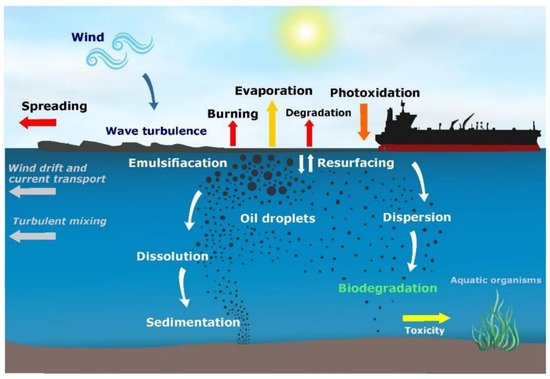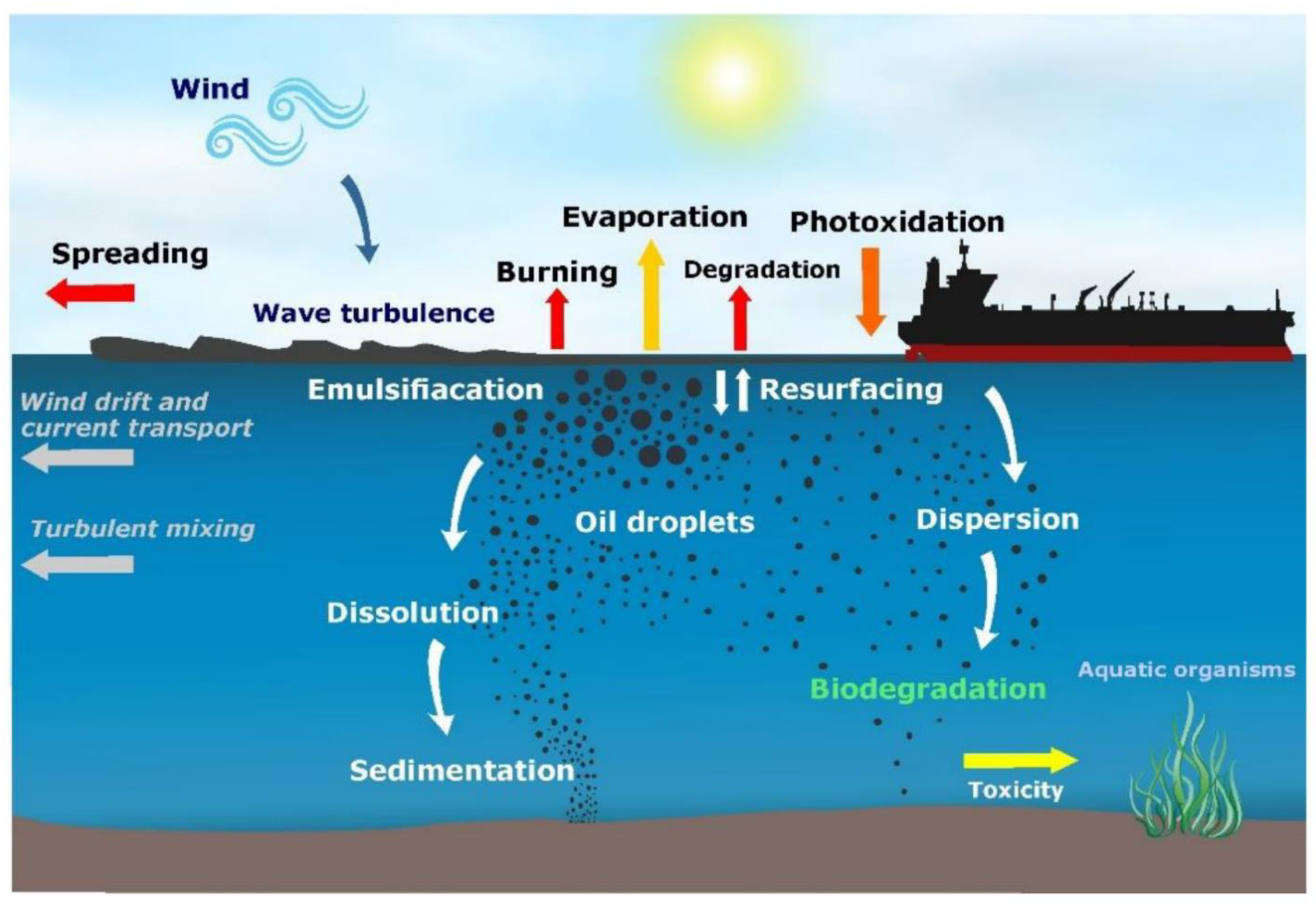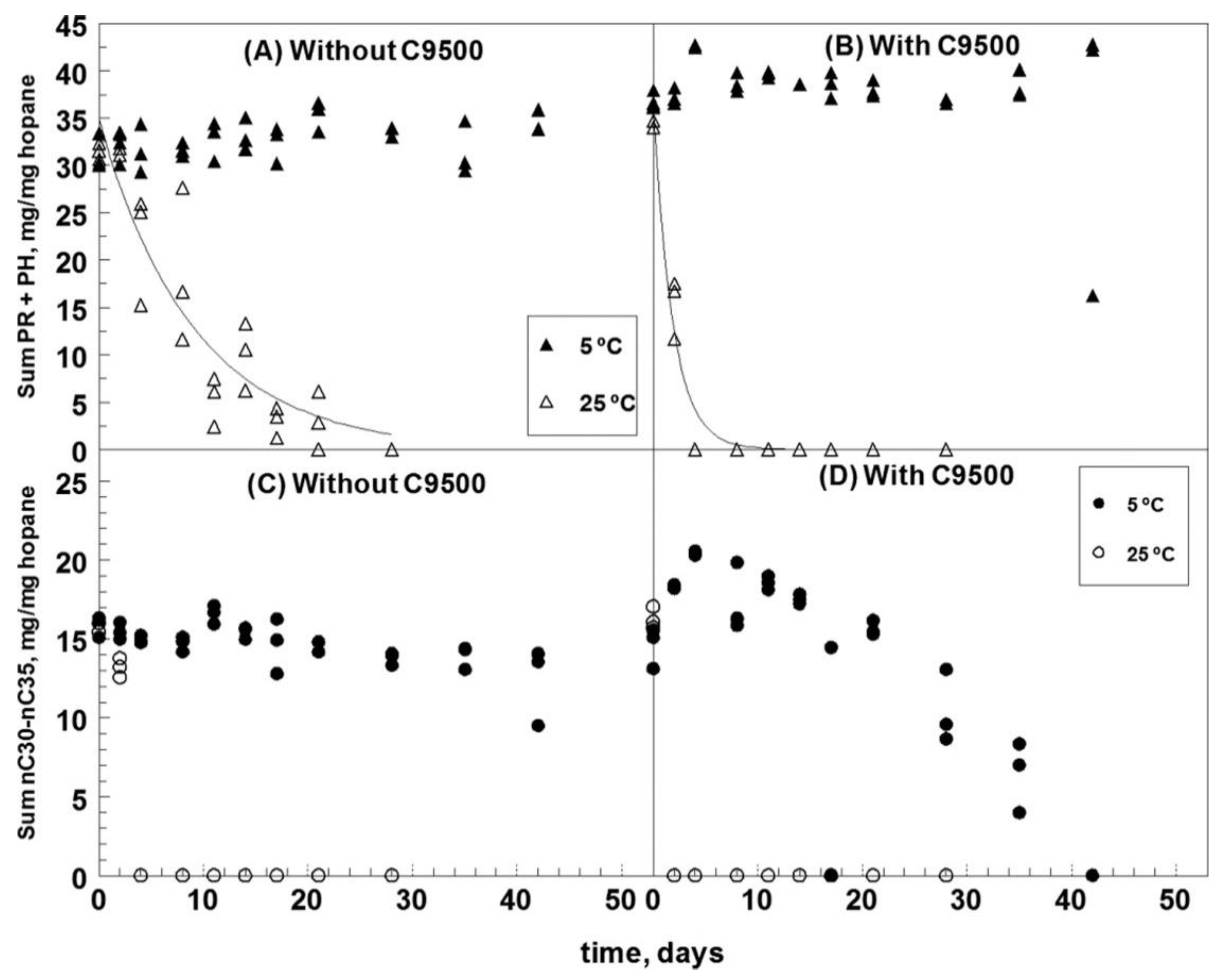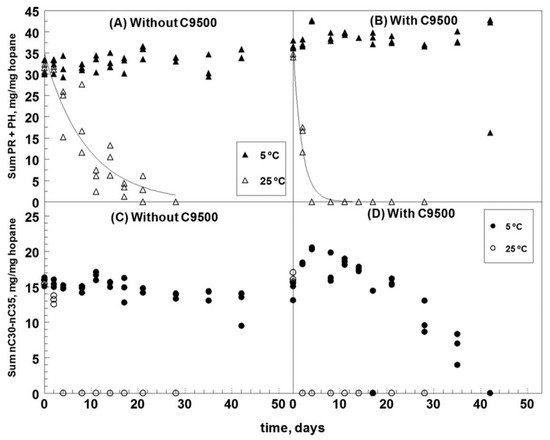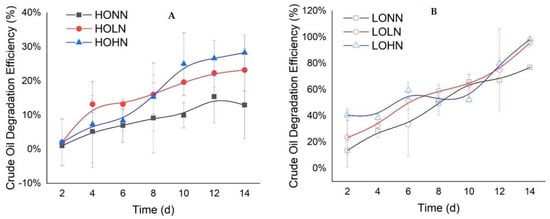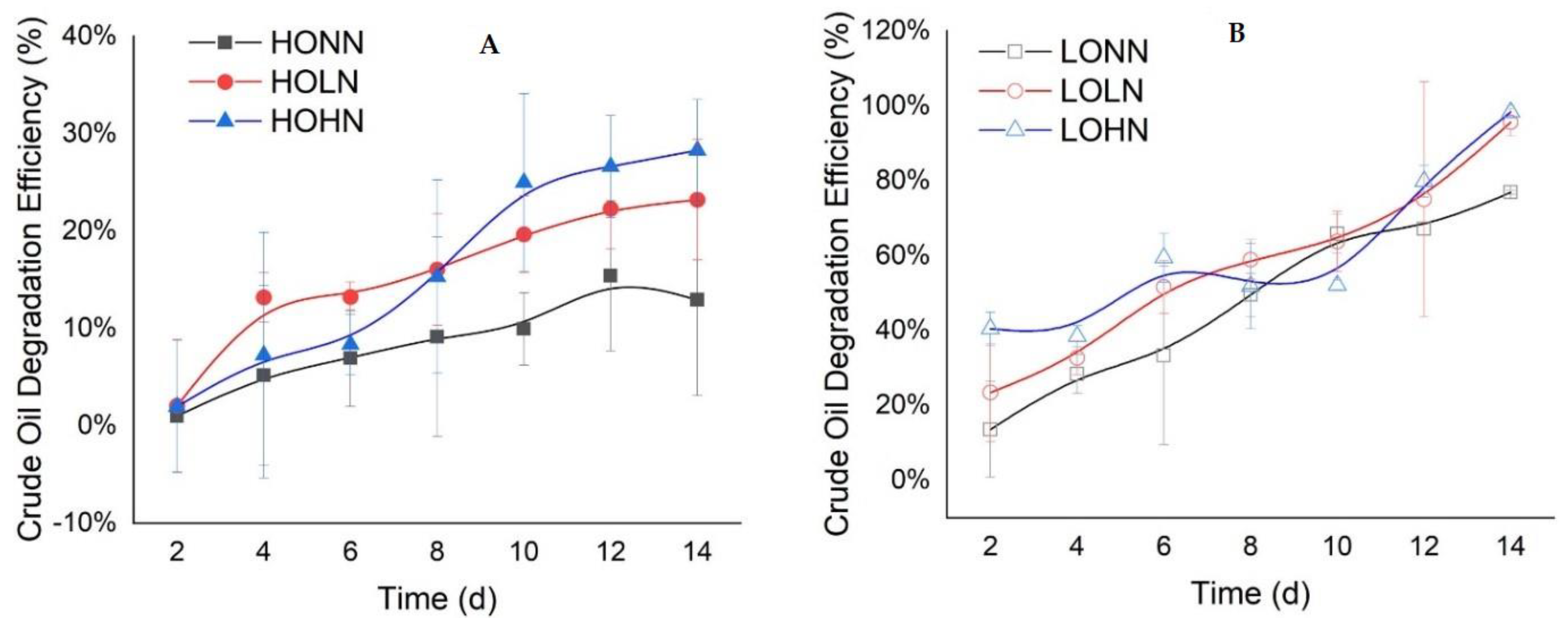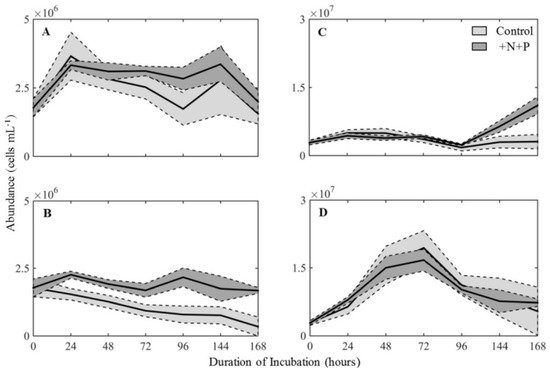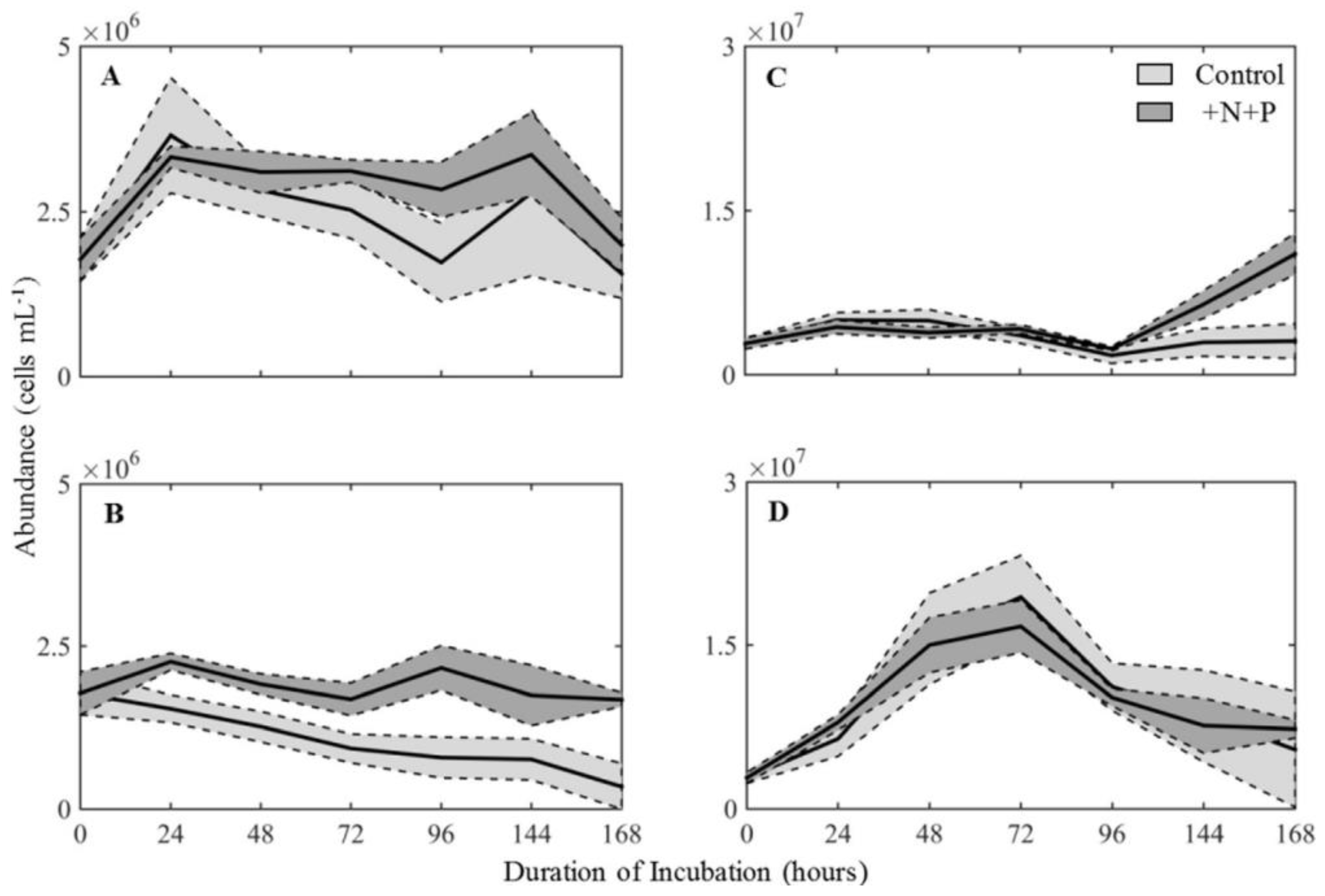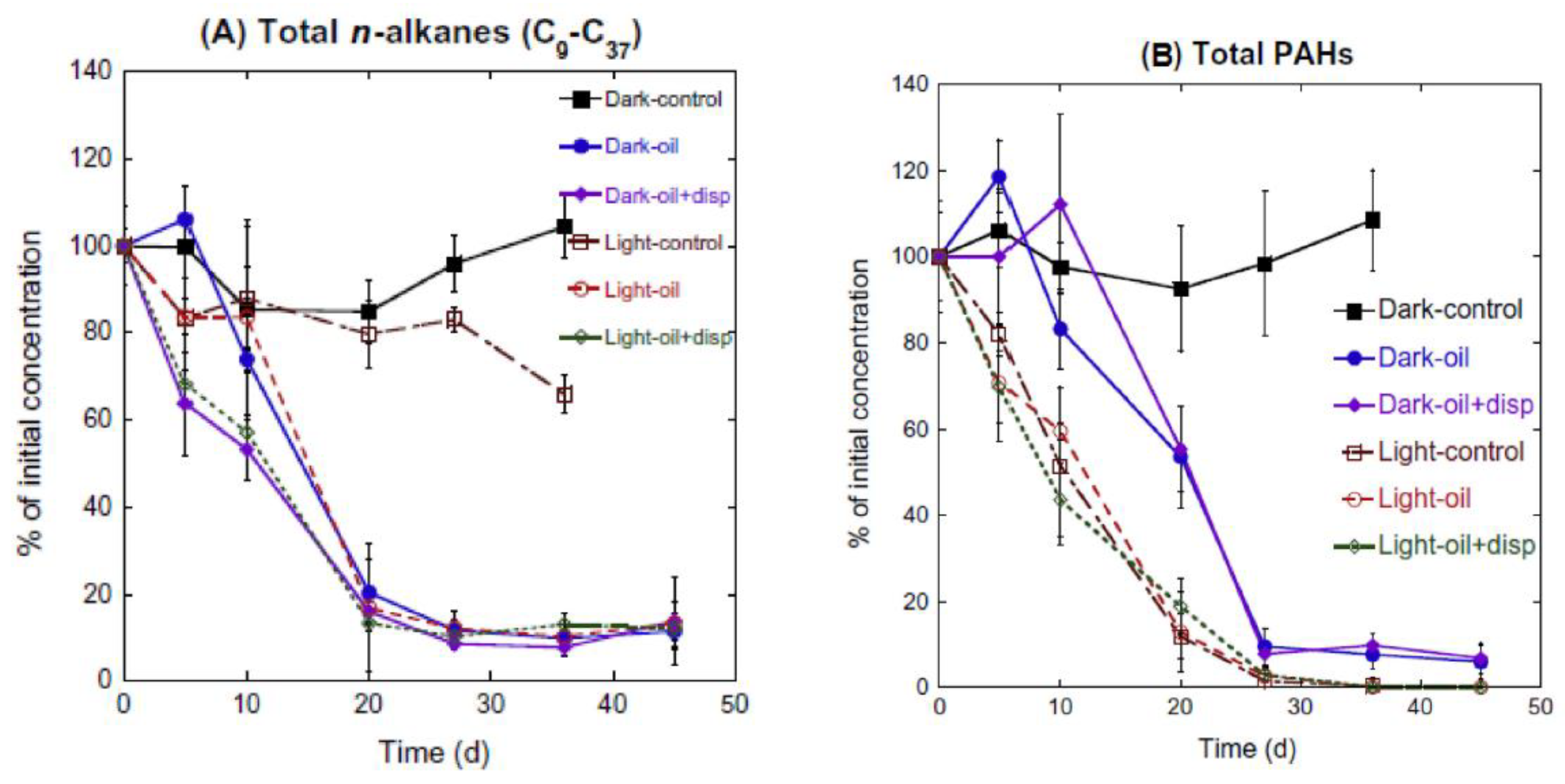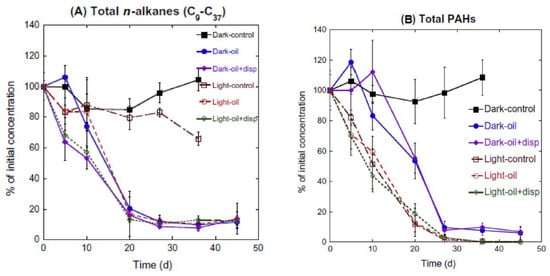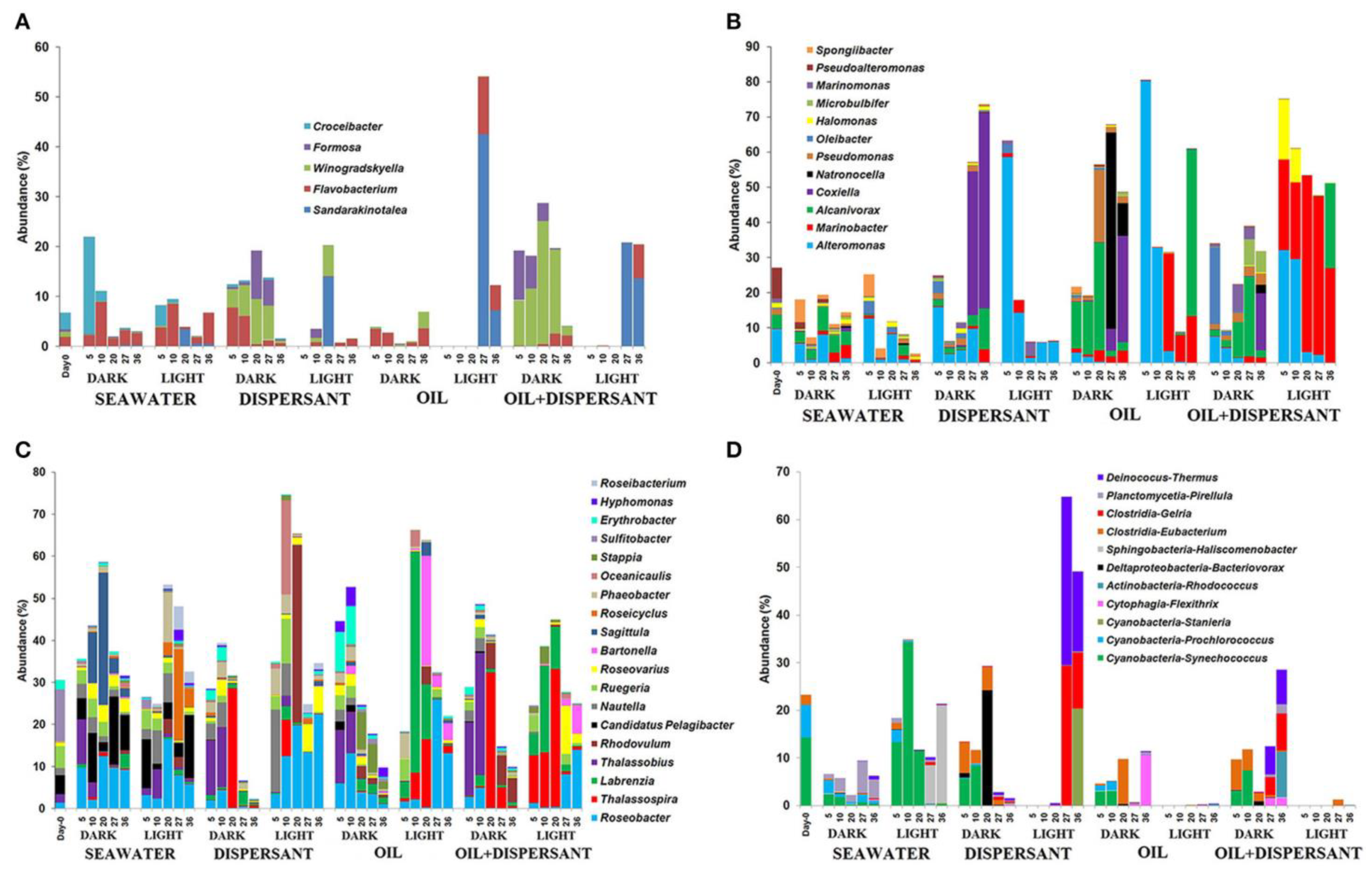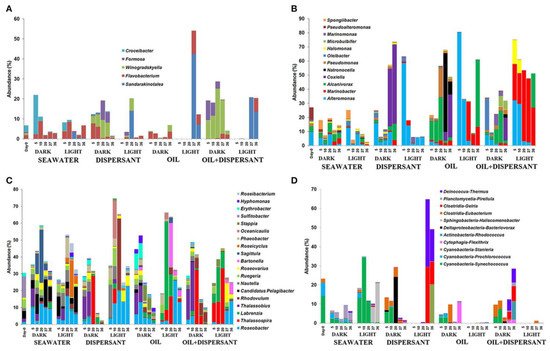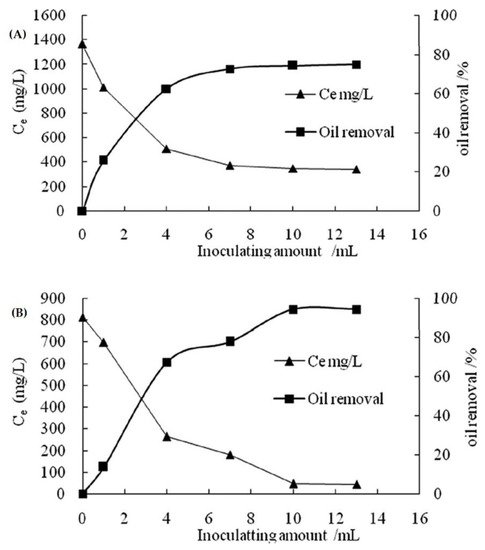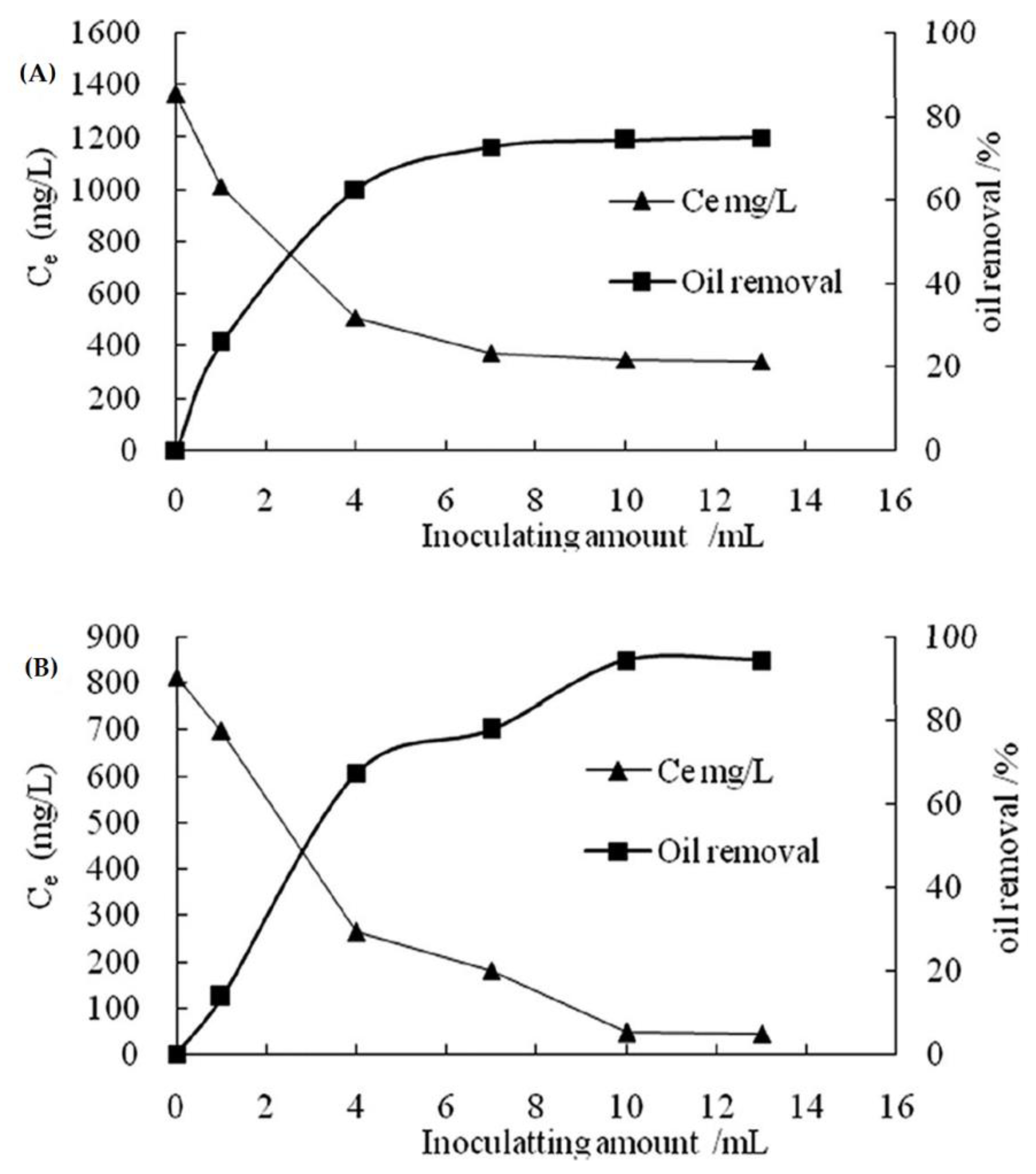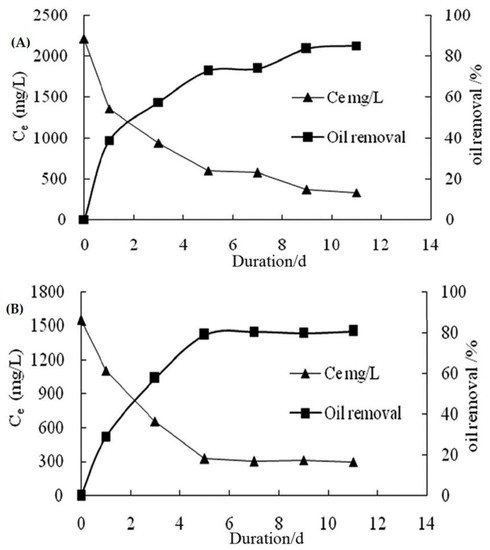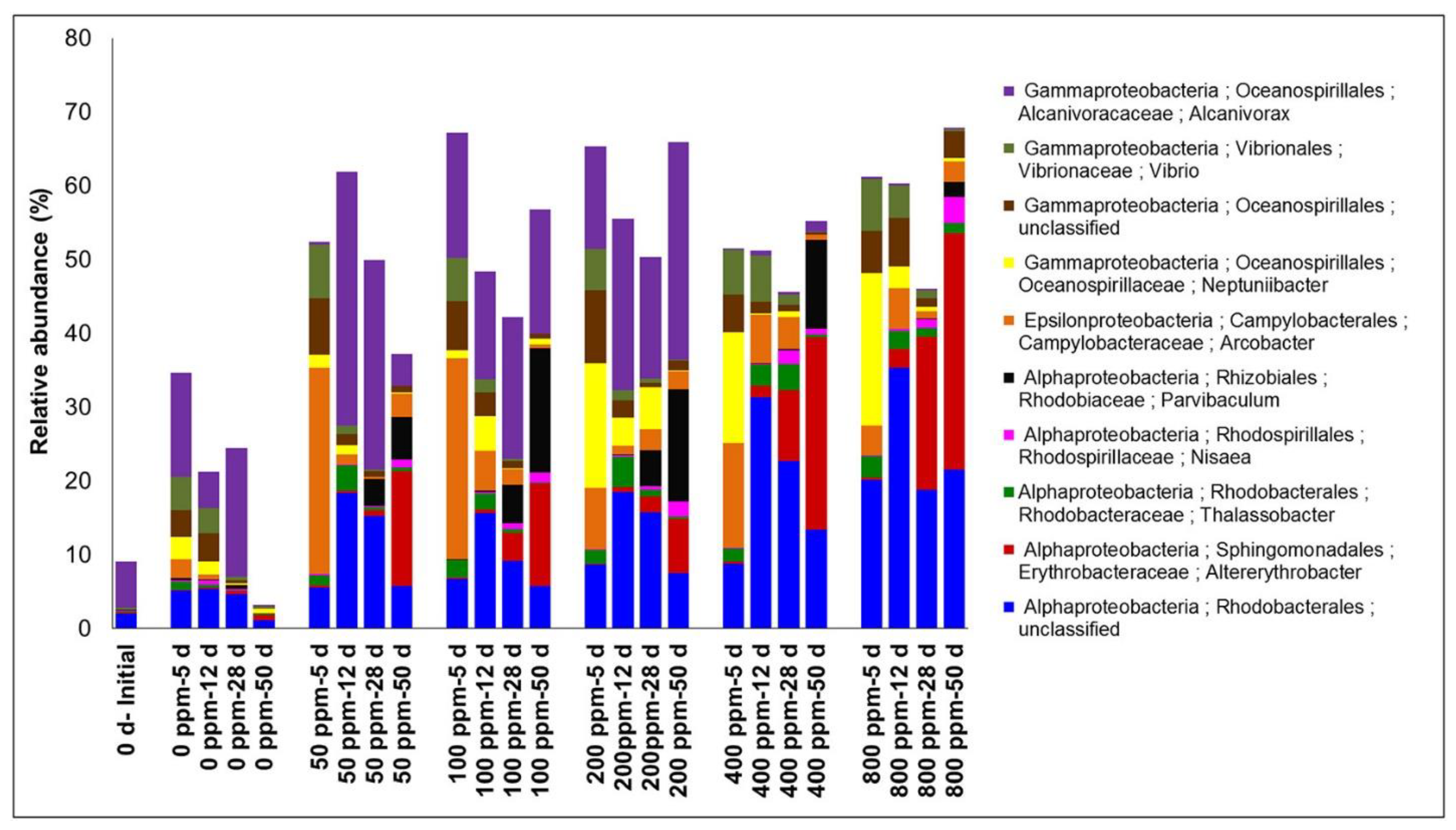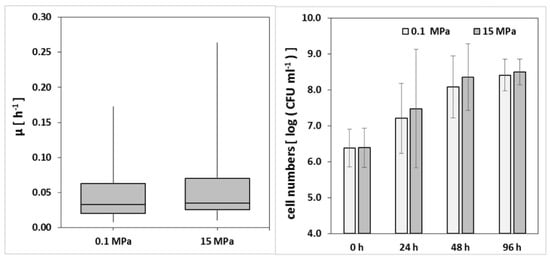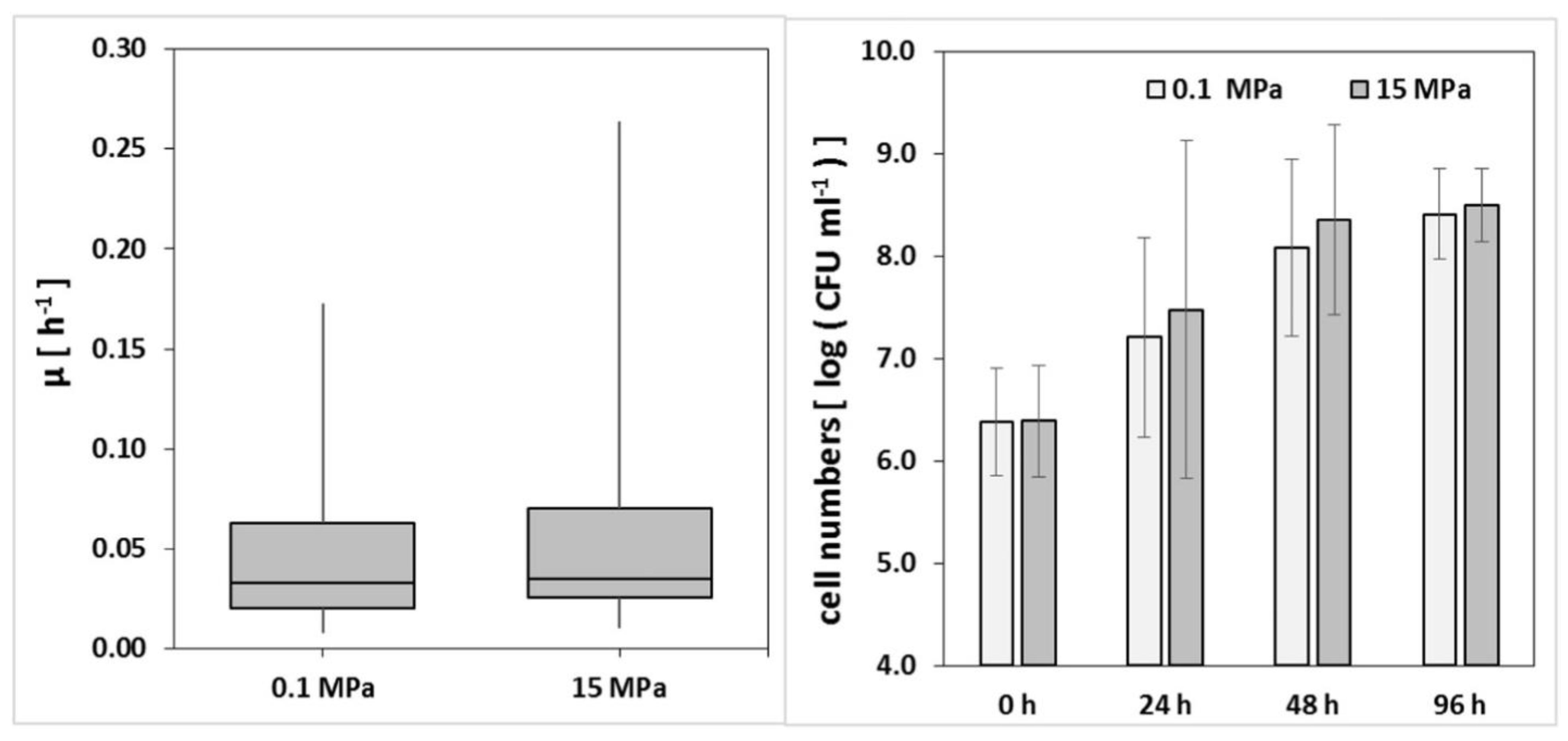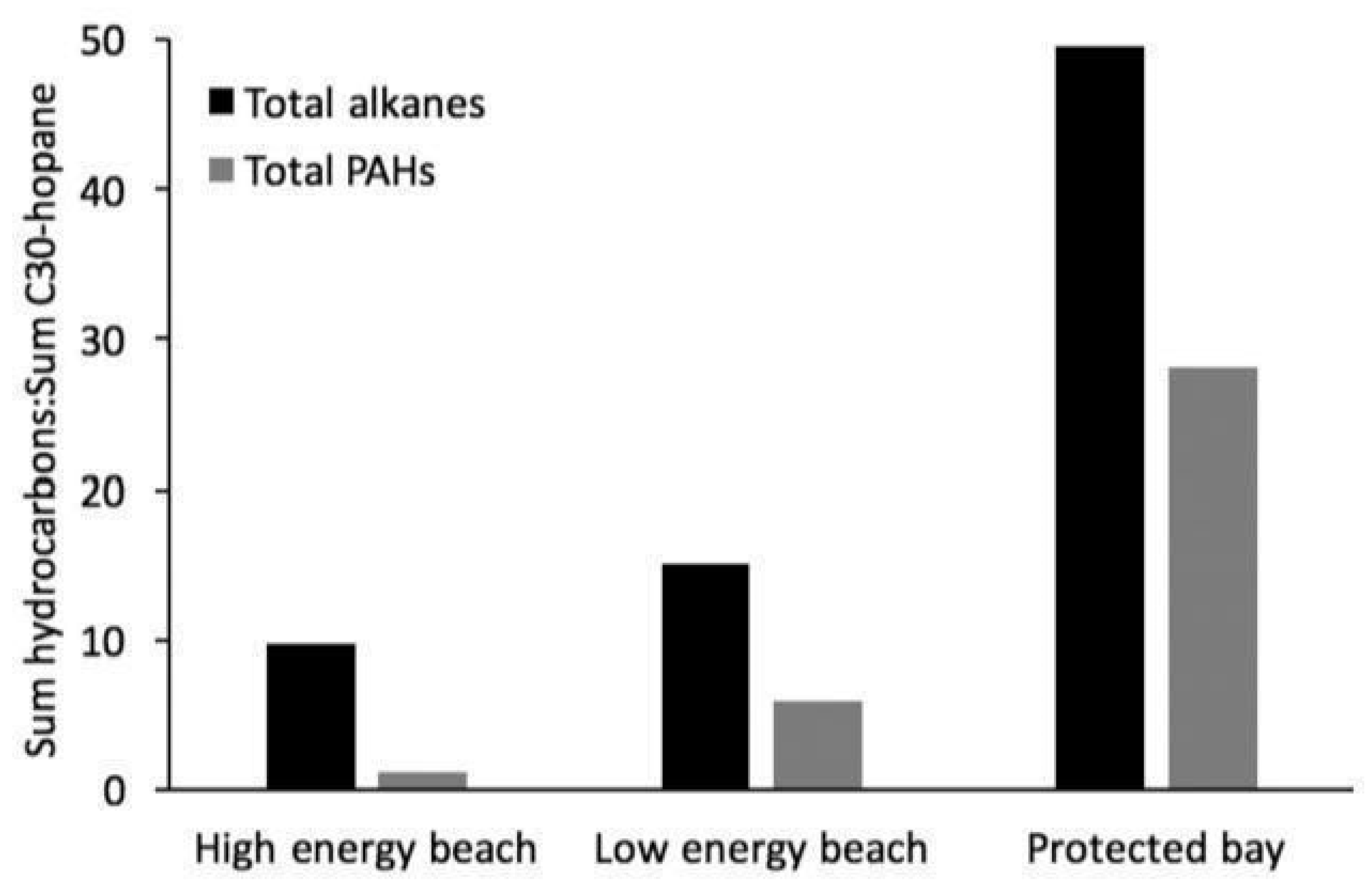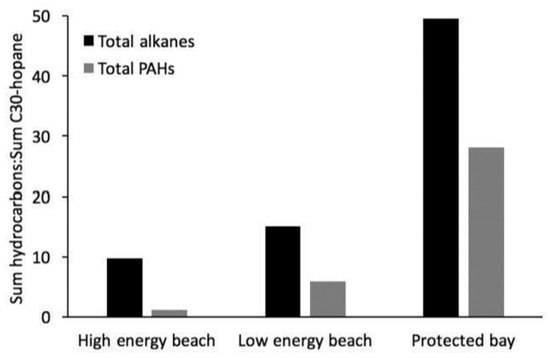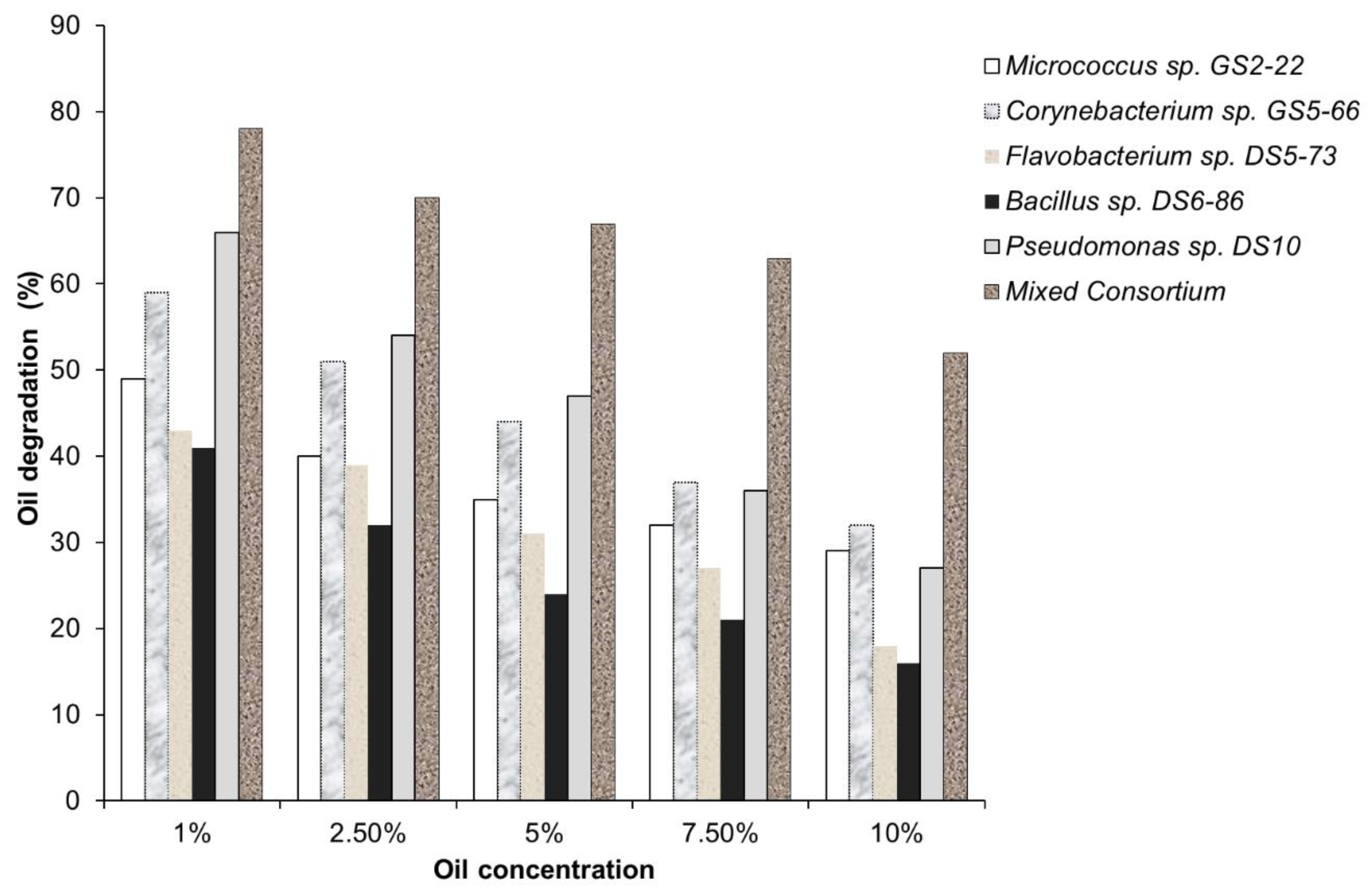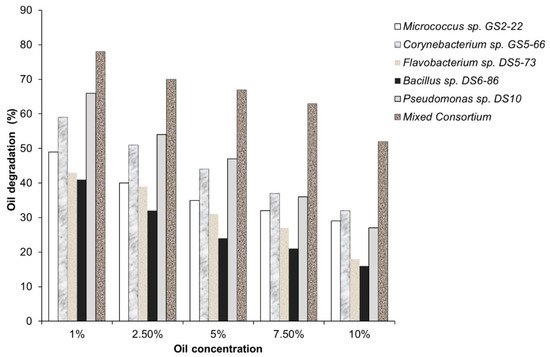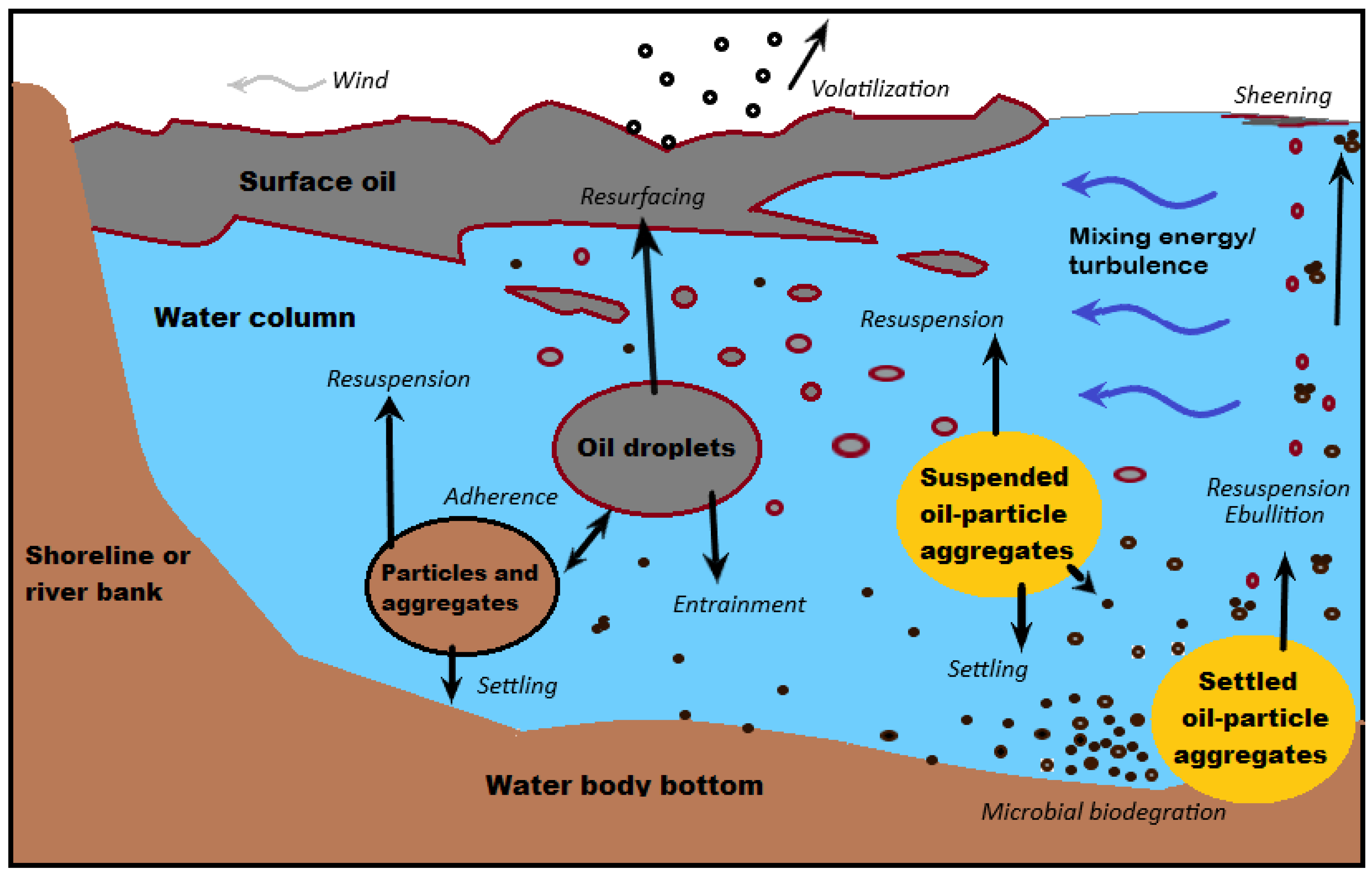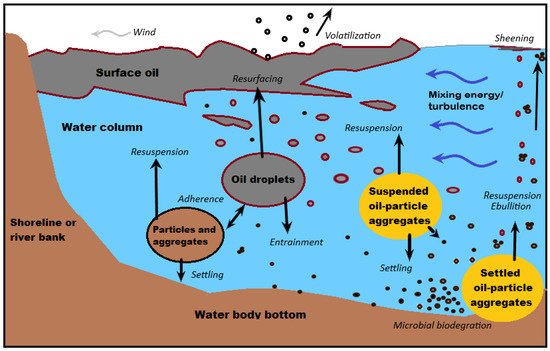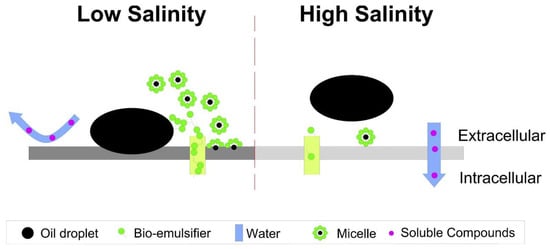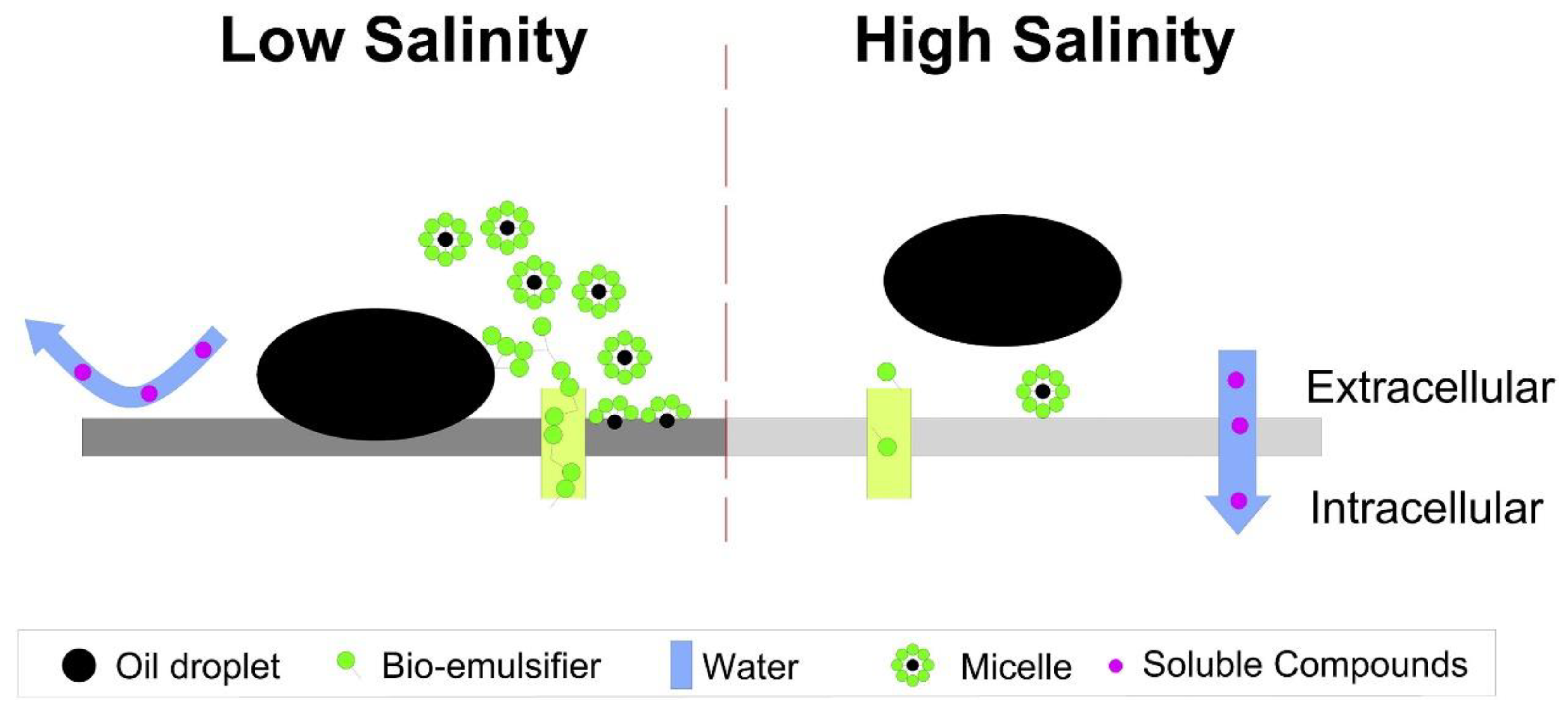1. Introduction
Marine environmental pollution has been closely associated with rapid industrialization and related human activities, including numerous incidences of oil spills. While the demand for petroleum has significantly increased in the past few decades, the usage and transportation of petroleum hydrocarbons began around the nineteenth century
[1][2][1,2]. Recently, there has been significant investment towards electric vehicles, however, the demand for crude oil is still growing in part due to its utility in other industries. Thus, accidental and sometimes intentional oil spills can be a great danger to marine ecosystems and the health of people in the surrounding community
[1]. Oil spills can occur during exploration, drilling, transportation, refining and production of petroleum, as well as during times of conflict. For example, the Deepwater Horizon (DWH) oil spill in 2010 occurred following an accidental explosion at a deep-sea drill site, which released over 200 million gallons (or 4.9 million barrels) of crude oil into the northern Gulf of Mexico
[3][4][3,4]. The fate of the spilled oil in marine environments depends on the composition of the oil, the weathering processes, and the prevailing environmental conditions
[5]. To assess the risk of oil spills in coastal-marine environments, it is important to understand the fate of spilled oil, as well as the persistence and degradation of potentially toxic constituent compounds in the spilled oil.
Marine oil spills are considered to have significant negative environmental, social, economic and health impacts. The potential health outcome caused by oil spills can be divided into different categories: the effect of the toxic/carcinogenic compounds to the workers involved in cleaning spilled oils; effects to visitors and the community as a whole; mental health problem caused by its social and economic disruption; and harm to the natural ecosystems
[6]. Short-term human health problems of oil exposure may include irritations, dizziness, and nausea; long-term effects may include damage to the respiratory, renal, endocrine, neurologic and hematologic systems
[6]. As recently seen during the DWH oil spill, fires, explosions and sinking of ships/oil rigs are also associated with oil spills, which can pose great harm to the workers and economic losses to the company
[7]. The spilled oil affects the environment by one or more mechanisms, such as physical smothering limiting locomotion or impacting physiological functions; chemical toxicity giving rise to death or impairment of cellular functions; ecological changes, including loss of key organisms from the community and the takeover of habitats by opportunistic species; lastly, indirect effects, such as the loss of habitat
[8][9][8,9]. Marine wildlife (e.g., seabirds, dolphins, whales, turtles, manatees) can be greatly affected by marine oil spills. For example, the death of seabirds due to oil slicks is of increasing concern, particularly as at-sea mortality is difficult to routinely monitor leading to potential underestimations of seabird mortality following an oil spill
[10].
When an oil spill occurs in offshore locations, a primary goal is to prevent the oil from reaching ecologically and financially important coastal habitats (including the coral reefs and the marshes) and to prevent it from affecting the onshore ecosystems
[11]. The primary prevention mechanism can include physical blocking of oil sheen, using floats, barrier walls or booms. Dispersants are also used to chemically disrupt the oil sheens by creating smaller droplets of oil which are more easily dispersed in water. For example, the environmental impact of the DWH oil spill was partially mitigated by applying Corexit 9500 dispersant on the surface waters (with the aid of planes and small vessels) and by injecting dispersant at the site of the spill, a deep-sea wellhead
[4][12][4,12]. Another way to reduce the impact of an oil spill is the controlled burning of oil on the site of the spill
[11].
Crude oils are typically composed of a large number of hydrocarbons, and their relative compositions vary widely depending upon the source of the crude oil. Hydrocarbons are a group of chemical compounds consisting of carbon and hydrogen atoms linked with covalent bonds that make them highly stable. Due to a lack of functional groups, these compounds show weak solubility in water
[13]. Crude oil is the most reduced form of natural hydrocarbons
[14], and these hydrocarbons are one of the great sources of energy for daily living and many industries
[15]. In general, crude oils contain alkanes and aromatic hydrocarbons, and resins and asphaltene hydrocarbons. Typically, the elemental composition of crude oil is approximately 83–87% carbon, 11–16% hydrogen, 0–4% oxygen plus nitrogen, and 0–4% sulfur
[11].
Some of the constituents of crude oil belong to the family of neurotoxic and xenobiotic organic pollutants
[16][17][16,17], which are known to be toxic and carcinogenic. For example, select polycyclic aromatic hydrocarbons (PAHs) in crude oils, consisting of two or more fused benzene rings, are known to be carcinogens and neurotoxic
[15][18][15,18], thus are the major contributors to toxicity during and after any spill. Because of their different metabolic pathways, PAHs produce metabolites with oxidative and carcinogenic properties and have the ability to attack and bind to DNA and proteins
[1][19][20][1,19,20]. As such, it is necessary to assess the capacity for compounds, such as PAHs, to degrade over time and space in order to predict toxicity.
Once oil spills into a coastal-marine environment, various natural processes act on spilled oil and oil residues over time to remove or degrade the oil compounds in the aquatic environment. These natural processes are called oil weathering, which include evaporation, dispersion, photooxidation, oxidation, emulsification and biodegradation (
Figure 1). Over longer periods, oil weathering processes contribute substantially to the reduction of spilled oil in the natural environment. Immediately following an oil spill, the volatile fractions (such as low molecular weight alkanes and monoaromatic hydrocarbons) evaporate, leaving the dense oil on the water surface as a slick which will undergo a series of physical and chemical changes known as weathering process. When waves and turbulent events happen, the oil slick will generate droplets by the virtue of their buoyancy onto the water column. Thus, the large droplets will eventually resurface while the smaller droplet will spread and diffuse into the water column. Although, this small droplet will remain in the subsurface for an extended period of time and can be resurfaced when there is a decrease in wave turbulence
[21]. The effects of toxicity of these oil residues on marine organisms and humans depend on a multitude of factors; e.g., composition (physical and chemical) of the residues, degree of weathering, exposure route and bioavailability
[1][22][23][24][1,22,23,24]. A dominant process responsible for the removal of petroleum compounds in the oil residues from the environment is believed to be biodegradation
[15].
Figure 1. Transportation, weathering and fate of spilled oil in the marine environment. Adapted from Keramea et al. [21].
Transportation, weathering and fate of spilled oil in the marine environment. Adapted from Keramea et al. [21].
Oil and oil residues in coastal-marine environments can be acted upon by naturally-occurring bacterial communities, ultimately leading to the disintegration of the oil components into carbon dioxide and water
[25][26][25,26]. A variety of microorganisms are known to have hydrocarbon biodegradation capacity, e.g., hydrocarbonoclastic bacteria. These microorganisms are naturally present in coastal-marine environments, even before the occurrence of oil spills, but they are mostly in low abundance in natural, unpolluted environments
[27][28][29][27,28,29]. They are widely distributed within surface water, sediments, and soil habitats, and the population of these bacteria rapidly increases after oil spills
[30][31][32][30,31,32]. Hydrocarbons are readily degraded under favorable conditions, nevertheless, there is a clear preference for the catabolism of some molecules before others; hence the composition of fuel or crude oil changes as biodegradation proceeds
[16][26][33][16,26,33]. Oil biodegradation can occur, albeit slower, even in deep and in areas with extremely low temperatures
[27][34][27,34]. As such, bioremediation of hydrocarbon pollutants is advantageous following an oil spill.
[35].
2. Factors Affecting Biodegradation of Oil Residues in Marine Environments
Despite the natural abundance of hydrocarbon-degrading bacteria, oil biodegradation and the interaction of bacteria and hydrocarbons are affected by various environmental factors. These factors include temperature, nutrients, sunlight, oxygen, type of oil, oil concentration, pressure, shoreline energy, pH, bacterial community, mineral particles, and salinity. This
pape
ntryr provides a comprehensive review of how these factors affect the bacterial activity and biodegradation of spilled oil and hydrocarbons in marine environments.
2.1. Temperature
The physical nature and chemical composition of oil residues, the rate of oil degradation, and the composition of microbial communities are influenced by ambient temperature
[15]. The sea surface temperature affects the microbial colonization of spilled oil and the degradation of hydrocarbons in marine environments. The effects of temperature on the biodegradation of petroleum hydrocarbons in the marine environment are two folds: changing the physical properties of oil and affecting microbial physiology
[15]. The composition and bioavailability of the spilled oil in seawater changes with temperature-dependent processes such as evaporation and dissolution, which are responsible for the disappearance of spilled oil
[36]. Low temperatures can crystalize some components of oil, consequently protecting them from microbial attacks
[37]. Temperature also affects microbial physiology, as the metabolic activities within microbial cells are temperature dependent. Enzymatic activities correlated with biodegradation of oil are reduced at low temperatures
[38].
Temperature is one of the most important factors causing differential biodegradation of alkanes and PAHs. In microcosm experiments with South Louisiana crude oil and the dispersant Corexit 9500, PAHs were undetectable by day 11 in the absence of dispersant and by day 4 in its presence when incubated at 25 °C as shown in
Figure 2 [37]. Alkanes are generally more amenable to biodegradation than PAHs
[16][17][33][16,17,33]. At 5 °C, however, the rates of PAHs biodegradation were unusually higher than alkanes, which was explained to be due to crystallization of all above tridecane at temperature ≤5 °C, reducing biodegradation
[37]. Additionally, bacterial communities that develop at low temperatures may prefer to degrade PAH over alkanes
[16][39][40][16,39,40]. At low temperatures, alkanes may be less accessible to microbial populations than the more soluble PAHs
[39][40][39,40].
Figure 2. Biodegradation of the branched alkanes (
A,
B) and
n-alkanes (
C,
D) >
nC
29 in the absence and presence of C9500 dispersant. Adapted from Campo et al.
[37]. (
A) Without C9500, (
B) With C9500, (
C) Without C9500, (
D) With C9500.
Temperature also influences the mass transfer of substrate and/or electron acceptors in frozen ground, crucial to the cold-adapted microbes and consequent bioremediation
[41][42][41,42]. In a study conducted on hydrocarbon bioremediation in simulated petroleum-polluted seawater collected from Tokyo Bay, it was found that the highest bioremediation efficiency was achieved in summer, followed by spring, autumn and winter respectively
[43]. Moreover, heavy fuel (Bunker C) biodegradation by indigenous organisms in the North Sea was four times greater in summer (18 °C) than in winter (4 °C). For example, the temperature threshold for remarkable oil biodegradation is around 0 °C in the Arctic/sub-Arctic environments
[44]. Although the microbial biodegradation activity does not cease at sub-zero temperatures, the process has not been thoroughly studied in the Arctic.
Among all environmental parameters, the most profound effects on bacterial communities are caused by temperature. Temperature affects the metabolic rates, including growth and survival, of microbes and determines the types of bacteria that can adapt to certain temperature ranges. The composition of the microbial community is affected by temperature as different types of bacteria are adapted to certain temperature ranges
[39]. During the DWH oil spill, the fluctuation in temperature was the main leading factor in the bacterial community shifts from the deep-sea plume to surface slick
[45][46][45,46]. For example, temperatures of 4 °C and 24 °C particularly select psychrophile and mesophile, respectively
[47][48][47,48]. Temperature influences the activities of environmental communities, with some heterotrophic bacteria responding positively with increasing growth
[49] and other smaller bacteria decreasing in growth
[50].
Liu et al.
[39] studied the deep and surface waters of the northern Gulf of Mexico for the roles of temperature, initial bacterial communities and nutrients in selecting oil degraders. The authors found that the development of microbial communities in high and low temperatures are different. The initial microbial community in the initial bottom water was primarily composed of α- and γ-Proteobacteria, Flavobacteria, Sphingobacteriia, Clostridia, and Opitutae. The microbial community shifted to mainly α-Proteobacteria (38 ± 15%) and γ-Proteobacteria (60 ± 16%) at 4 °C incubation to a less diverse community, which is dominated by Sulfitobacter. At 4 °C incubations, higher percentages of α-Proteobacteria (47 ± 17%) and lower percentages of γ-Proteobacteria (34 ± 19%) were found.
Cycloclasticus, a known PAH degrader, dominated on day 50 at 4 °C but was nearly undetectable at 24 °C. The surface water had Cyanobacteria (60.4%), as the dominant bacterial community. At 4 °C incubation, Cyanobacteria was reduced to 10–30%. However, these Cyanobacteria were nearly undetectable at 24 °C. At 4 °C incubation,
Sulfitobacter was the most dominant genus while at 24 °C,
Oleibacter and
Alteromonas predominated
[39]. Total
n-alkanes generally degrade faster at 24 °C, while PAHs decrease faster at 4 °C. Alkanes are generally more amenable to biodegradation than PAHs, however,
n-alkanes above tridecane crystallize at ≤5 °C, thus, at a lower temperature, more soluble PAHs degrade faster. Moreover, the bacterial communities that develop at low temperatures may preferably degrade PAHs over alkanes.
2.2. Nutrients
Nutrients play a crucial role in the biodegradation of spilled oil
[51]. The microbial activity is limited by the presence of inorganic nutrients such as nitrogen (N), phosphorus (P), and potassium (K), which are essential for microbial growth
[52]. The availability of nutrients in seawater varies in different seasons, such as when nutrients are scarce in the fall and winter but abundant in the spring and summer
[53]. Moreover, nitrate and phosphate are typically enriched in deep water, but depleted in surface water, and may regulate the development of oil-degrading bacterial communities
[54][55][56][54,55,56].
Recent studies show that the addition of nutrients increases the degradation efficiency of oil. For example, Chen et al.
[7] reported that a 10.0 g/L of crude oil-polluted water amended with 0.02 g/L and 2 g/L of nutrients showed a significant increase in degradation (76.9% and 155.4% increase. respectively) (
Figure 3). Similarly, 0.01 g/L of oil amended with the same nutrients showed an increase of 20.4% and 24.0%
[7]. Another study that used a combination of N and P observed a significant removal of 70% of lighter and 65% of heavier alkanes for just 1 h of incubation
[57]. The addition of enough fertilizers that contain bioavailable nitrogen and phosphorus has been recorded to enhance oil biodegradation
[27], increasing the hydrocarbon respiration rate
[7][58][7,58]. The addition of N and P to marine sediments in Malaysia showed to stimulate alkane-degrading microbes, resulting in a decrease in
n-alkane
[59]. Laboratory results from the Gulf of Mexico show that the respiration rate in slick samples is five times higher than outside the slick, indicating that microorganisms in these oligotrophic waters quickly adjusted to breaking down hydrocarbon substrates
[54]. This is due to inorganic nutrient amendments, which boost bacterial biomass and respiration.
Figure 3. Biodegradation efficiency of crude oil with nutrient addition over 14 days of incubation. Three experiments with high oil concentration of oil 10 g/L are illustrated in (
A), first with high oil concentration with no added nutrient (HONN), second with high oil concentration with low nutrients added (0.02 g/L of nutrient) (HOLN), and lastly, high oil concentration with high nutrients added (2 g/L of nutrients) (HOHN). Similarly, three experiments with a low oil concentration of 0.01 g/L of crude oil are illustrated in (
B) low oil concentration with no nutrient added (LONN), low oil concentration with low nutrients added (0.02 g/L nutrients) (LOLN), and lastly, low oil concentration with high nutrients added (2 g/L nutrients) (LOHN). Adapted from Chen et al.
[7].
However, other studies reported that the addition of more nutrients can inhibit biodegradation activity
[60][61][62][60,61,62]. Having too many nutrients is considered to be toxic to cell growth, while the optimum concentration of fertilizers at 0.1% concentrations is best for the degradation of oil
[63][64][63,64]. High concentrations of N, P. and K levels can contribute to the inhibition of biodegradation activity
[65][66][65,66]. It is important to note that different microbial communities have different ratios of N/P optimum for the degradation of different hydrocarbons
[67]. Excess nutrients can cause changes in lakes, rivers, and coastal ecosystems
[68], resulting in unfavorable consequences like eutrophication
[67]. Eutrophication can cause the reduction of biodiversity in both autotrophic and heterotrophic organisms
[68], including biodegrading microorganisms.
Nearshore habitats are rich in microbial communities that provide services such as nutrient regeneration and the removal of pollutants
[69][70][69,70]. These specific oil-degrading bacteria developed differently in rich nutrient and low nutrient environments from bottom water (nutrient-rich) to the surface water (nutrient-poor) environment.
Alteromonas, Pseudoalteromonas, Oleibacter, and
Winowgradskyella have been observed to grow better at bottom water-rich nutrient environments while
Reinekea and
Thalassobius develop better in surface water.
[39]. Dave & Vya
[52] found that the addition of nutrients beyond their maximum concentrations will have no significant effects, that adding phosphorus to three isolates
M. albus,
M. mesophicum, and
N. otitdiscavairum at concentrations of 0.1% and 0.5% boosts growth and biodegradation rates, with a maximum of 0.5 concentration. Following the addition of nitrogen (concentrations from 0.1% to 1%), there was an increase in both biodegradation and growth rate on the three isolates. Lastly, potassium fertilizer addition at a maximum of 0.01% on the three isolates results in the decrease of degradation and growth rate
[52].
During oil spills, it has been recorded that at least an estimated 150 g of N and 30 g of P are needed to be able to convert 1 kg of hydrocarbon to cell material
[71]. An incubation of Galveston Bay seawater shows that the presence of oil tends to increase the abundance of heterotrophic bacteria regardless of nutrient concentration, but autotrophic microbial plankton decreased in abundance with the presence of oil (
Figure 4). However, the addition of nutrients ameliorated the effects of oil on the autotrophic microbial community, such that it increased the abundance of all microbial groups in the nutrient treatments leading to a significant decrease in oil
[31]. The addition of N in oil-polluted sites does not just increase the cell growth; it can also contribute to the decrease of lag phase and can result in maintaining a high microbial population
[66][72][66,72].
Figure 4. Comparing the microbial plankton abundance in incubated treatments over a total of 168 h, without nutrient enrichment (control) and with nitrogen and phosphorus (+N, +P). The black line is the mean value while the shaded represents standard deviation among the three replicates. The concentrations of autotrophic cells are illustrated in (
A) for Station 2 and (
B) for Station 3. As well, the concentrations of heterotrophic cells at Station 2 and Station 3 are illustrated in (
C,
D), respectively. Adapted from Williams et al.
[31].
2.3. Sunlight
Sunlight is an important factor affecting the degradation of crude oil and oil residues following an oil spill in marine environments. Specifically, photooxidation through the action of ultraviolet (UV) light from sunlight is one of the most important processes in the weathering of the spilled oil in surface water and is very effective at oxidizing 3 to 5 ring aromatics hydrocarbons in floating slicks and stranded oil
[73][74][73,74]. Aromatics components of crude oils (e.g., PAHs) are the most photosensitive, followed by
n-alkanes
[75], although cyclic alkanes may decrease even faster than aromatic compounds
[76].
There are two ways oil photooxidation can occur, direct and indirect photooxidation
[77]. In direct photooxidation, compounds in crude oil such as PAHs are oxidized through direct absorption of sunlight. Indirect photooxidation happens when a wide range of reactive products are produced from crude oil during the absorption of sunlight such as singlet oxygen, peroxy radicals and hydroxyl radicals which oxidize other compounds in oil but not those that directly absorbs sunlight
[77]. Thus, when the direct pathway is dominant, oxidation would be limited to a tiny fraction: only crude oil components that absorb light directly from the sun. Whereas, if the indirect photooxidation pathway is dominant, a much larger fraction of spilled oil would be vulnerable to oxidation
[77].
Crude oil is typically exposed to photooxidation as a film or dissolved in surface waters known as the water-soluble fraction (WSF). The PAHs in WSF have exhibited a high degree of photooxidation, while PAHs in oil film have been shown to be less affected
[78][79][80][78,79,80]. The greater the size and alkyl substitution, the higher is the sensitivity of aromatic compounds present in the crude oil to photooxidation. In the case of the DWH oil spill, it was suggested that the photooxidation pathway was indirect oxidation
[81], such that hydroxyl radicals and singlet oxygen were formed
[80]. It was reported that photooxidation was the main driver for degrading aromatic hydrocarbons, and biodegradation was the key process controlling the degradation of saturated hydrocarbons (
Figure 5). Bacosa et al.
[33] observed that photooxidation could degrade up to 40% of PAHs in 10 days and 90% of PAHs in 20 days. On both light and dark incubations,
n-alkanes degrade faster in dispersed than in non-dispersed oil (
Figure 5A). On the other hand, sunlight drove the degradation pattern of PAHs and their alkylated homologues (
Figure 5B). Individual PAHs with lower molecular weight were more sensitive to photooxidation than PAHs with heavier molecular weight. After a long period of exposure to sunlight, about 60% of alkanes were degraded after 10 to 20 days with bacteria present
[33]. Alkane degradation decreases as chain length increases. Also, specific types of alkanes (e.g., pristane and phytane) were almost completely depleted in the dark, an unexposed treatment, but has shown no significant hint of degradation in the light, exposed treatment even with the aid of a dispersant
[33]. In general, unalkylated PAHs degrade slower than their alkylated homologues, and with the alkylation of each family, the removal of alkylated PAHs is increased
[82].
Degradation of total (
)
-alkanes and (
B) PAHs under dark and light conditions. Adapted from Bacosa, et al. [33].
) PAHs under dark and light conditions. Adapted from Bacosa, et al. [33].
Photooxidation can also increase the number of oil components susceptible to biodegradation, which is essential in the growth of oil-degrading bacterial communities
[33][83][33,83]. In general, sunlight reduces the bacterial diversity and evenness in waters amended with crude oil alone, as well as with dispersed crude oil. Bacteria exposed to sunlight have been shown to be more dispersed with the change in oil chemistry compared to those that are unexposed to sunlight
[33][84][33,84]. Sunlight has been shown to inhibit the growth of some bacterial species, but favor the growth of others (
Figure 6) including
Alteromonas, Marinobacter, Labrenzia, Sandarakinotalea, Bartonella, and
Halomonas genera. On the other hand, crude oil-polluted water that has not been exposed to sunlight favored the growth and abundance of
Thalassobius,
Winogradskyella,
Alcanivorax,
Formosa,
Pseudomonas,
Eubacterium,
Erythrobacter,
Natronocella, and
Coxiella [84]. Sunlight-favored bacteria were predominant after examining the mousse that is exposed to sunlight. This suggests that high surface temperature and/or strong sunlight played an important role in the growth and development of the bacterial community in oil-polluted waters.
Figure 6. Abundances of bacteria at genus level in seawater alone, seawater with dispersant Corexit, crude oil, and both oil and dispersant incubated under the dark and light conditions for 36 days. Only abundances greater than 5% in at least one of the samples are shown. (
A) Flavobacteria, (
B) Gammaproteobacteria, (
C) Alphaproteobacteria, (
D) Other bacteria. The numbers indicate days of incubation. (Adapted from Bacosa et al.
[84].)
Oil is an important source of hydroxyl radicals. A series of experiments have revealed that the total amount of singlet oxygen and hydroxyl radical produced in the irradiation of the thin oil films (100 mg) taken over the Gulf of Mexico were 2.0 × 10
−5 and 3.7 × 10
−7 moles, respectively
[85][86][85,86]. Photo-produced singlet oxygen and hydroxyl radicals in steady-state concentrations were near 1 × 10
−12 and 1.2 × 10
−12 M in seawater under thin films of oil
[85]. In the case of Macondo oil (DWH oil), it was observed that 90% of 350 nm radiation attenuated in the first 9 µm of the 60 µm film and that lower steady-state concentrations were produced by thicker oil than that of the thinner oil. This suggests why singlet oxygen formed at the very surface of the oil film were unlikely to diffuse through viscous oil to reach the aqueous layer
[85]. Also, the Macondo oil produces higher triplet state energies than the natural dissolved oxygen matter
[86], which can be explained by the relatively high concentrations of PAHs in oil
[87].
When exposed to oil, bacteria release extracellular polymeric substances or EPS forming a microbially colonized matrix to which cells and other particles can attach
[88][89][88,89]. EPS is a precursor of marine oil snow observed such as those during the Deepwater Horizon oil spill
[90]. Marine snow can scavenge oil particularly heavy molecular PAHs
[91]. EPS is produced as one of the microbial defense strategies against harmful or stressful conditions such as oil spills. EPS is mainly composed of protein and carbohydrates and different bacteria produce varying ratios of protein to carbohydrates
[88][92][88,92]. Recently, strong evidence suggests that the stickiness of the EPS is due to its high protein content
[93]. Sunlight plays an important role in EPS formation during an oil spill. In the presence of oil, natural sunlight stimulates polysaccharide secretion, coinciding with increased reactive oxygen production
[89]. Moreover, oiled water irradiated with natural sunlight produces larger size aggregates suggesting that sunlight induce aggregation of bacterial EPS in marine environments
[89][94][89,94].
2.4. Oxygen
Aerobic conditions are generally considered necessary for extensive degradation of oil hydrocarbons in the environment since major degradation pathways for petroleum hydrocarbons involve substrate oxidation by oxygenases in the catabolism of alkanes, cyclic, and aromatic hydrocarbons
[95][96][95,96]. The initial intracellular attack of organic hydrocarbons is an oxidative process, whereby activation and incorporation of oxygen are catalyzed by oxygenases and peroxidases
[13]. The aerobic bacterial catabolism of aromatic compounds involves a wide variety of peripheral pathways that activate structurally diverse substrates into a limited number of common intermediates, which are further cleaved and processed by a few central pathways to the central metabolism of the cell. Metabolic pathways and encoding genes responsible for the degradation of specific aromatic compounds have been characterized for many isolated bacterial strains, predominantly from
Proteobacteria and
Actinobacteria [97].
According to McNally et al.
[98] and Grishchenkov et al.
[99], the biodegradation of PAHs was slower in anaerobic conditions compared to aerobic conditions. Under aerobic conditions, the bulk of organic pollutants degrade at the fastest and most complete rate
[100]. This has been demonstrated in research by Mille et al.
[101] (
Table 1), for example, who found that when the dissolved oxygen concentration in the overlying seawater was 8 ppm and the redox potential was around +150 mV, hydrocarbon degradation was noticeable. After reducing the dissolved oxygen concentration (2–3 ppm) and the redox potential (+30 mV), the degradation slowed down 2–3 times. Furthermore, there was no degradation under sub-oxic conditions (dissolved oxygen 0.2–0.3 ppm and redox potential −180 to −200 mV). Kostka et al.
[102] suggested that the activation of hydrocarbon molecules during degradation is energetically demanding for microorganisms in the absence of oxygen, and thus anaerobic hydrocarbon degradation is much slower in comparison to aerobic metabolism. The supply of oxygen and major nutrients controls oil biodegradation.
Table 1.
Percentage of biodegradation of spilled oil in sediments after a 60-day incubation. Adapted from Mille, et al. [101].
| Reactor |
Redox Potential
(mV) |
Biodegradation (%) |
|
| Extractable Organic Matter (EOM) |
Saturated Fraction (FS) |
Aromatic Fraction
(FA) |
| 3 (8 ppm O2, stirring) |
150 |
64 |
70 |
59 |
| 4 (8 ppm O2, without stirring) |
90 |
55 |
61 |
52 |
| 5 (2–3 ppm O2) |
30 |
11 |
20 |
17 |
| 6 (0.2–0.3 ppm O2) |
−190 |
NS |
NS |
NS |
Beaches are dynamic systems where water and sediments mix easily are suitable for hydrocarbon degradation as they mostly have aerobic conditions
[69][70][69,70]. However, in areas such as salt marshes where oxygen is easily depleted, a slower biodegradation rate is expected because anaerobic hydrocarbon degradation is slower than aerobic degradation
[70]. According to Nicholson & Fathepure
[103], the ability of halophilic and halotolerant bacteria to rapidly degrade benzene, toluene, ethylbenzene, and xylene (BTEX) compounds under aerobic conditions is high, and such activity could be enhanced markedly by the addition of growth-promoting nutrients such as yeast extract (YE).
A number of petroleum hydrocarbons (e.g., aliphatics and polyaromatics) have been demonstrated to utilize oxidizing processes in their breakdown pathways; however, these processes range substantially due to the varied oxygenases found in different bacterial species. Moreover,
Alcanivorax borkumensis, a surfactant-producing marine bacterium
[104],
Cycloclasticus pugetii which uses aromatic compounds, including biphenyl, naphthalene, phenanthrene, anthracene, and toluene as principal carbon sources for growth
[105] and
Oleispira antarctica, a novel hydrocarbonoclastic marine bacterium isolated from Antarctic coastal seawater are specific bacteria known to degrade hydrocarbons under aerobic conditions
[106].
2.5. Type of Spilled-Oil
Crude oils are generally categorized into light and heavy oils. Light oils, which yield gasoline, jet fuels, diesel and kerosene, typically consist of hydrocarbon chains ranging from C
8–C
20 which are less complex hydrocarbons and more easily degradable
[107]. Heavy oils, which yield transportation fuels and act as a source of raw material for plastics, petrochemicals, lubricants, and road surfacing, are generally comprised of complex branched and ringed carbon chains > C
20 so fewer microorganisms can degrade them and biodegradation rates are slower
[107]. Previous research has proven that microbial degradation is a key step in deciding the destiny of spilled oil, which implies that microbial biodegradation is one of the primary mechanisms for removing non-volatile crude oil components from an oil-contaminated environment where bacteria that degrade hydrocarbons are prevalent
[108]. Microbial biodegradation also has been found to occur naturally in the remediation of oil pollution linked with a number of oil spills
[109][110][109,110]. In addition to that, the duration and essence of hydrocarbons in oil-derived compounds depart from C
1–C
10, as in gasoline
[111]; C
9–C
16, as in jet fuel
[112]; C
10–C
18, as in kerosene
[113]; >C
12, as in diesel fuel/oil
[113]; and C
20–C
50, as in heavy Crude oil and waste oil/lubricating oil
[113][114][113,114]. More complex structures (those with branches, higher hydrocarbon number, and/or condensed ring structures) are more difficult to biodegrade
[107]. Moreover, in the case of PAHs, it has been observed that several genera of bacteria use lower-molecular-weight PAHs with two or three fused aromatic rings as their only source of carbon and energy
[115].
Using 16S ribosomal DNA, a study characterized an isolate capable of degrading gasoline. It shared 100% sequence identity with a reference strain of
Mycobacterium austroafricanum and degraded 86% of the substrate during growth on gasoline
[116] (
Table 2). It has been reported that the strain
Mycobacterium austroafricanum, IFP 2173, was capable of degrading 3-methyl groups via a carboxylation and deacetylation process. Kerosene amended water was dominated by microbial communities of the genera
Achromobacter, Alcaligenes, and Cupriavidus [16]. Degradation tests in sealed 120 mL vials of 1% kerosene showed that aromatic fractions deteriorated faster than aliphatic fractions
[16]. Aromatic fractions, which are more toxic than aliphatic fractions, were preferred by the microbial consortium. Furthermore, in diesel incubations,
Pseudomonas aeruginosa,
Acinetobacter lwoffii,
Corynebacterium sp. were found during incubation with a 1% concentration of the oil
[117]. The identified bacterial consortium utilized all observable hydrocarbon peaks inherent in diesel within 14 days
[117].
Table 2.
Major classifications of spilled oil and corresponding valuable biodegrading bacteria.
| Oil |
Carbon Composition |
Oil Concentration |
% of Oil Biodegraded |
Dominant
Bacteria |
Isolate or Consortium |
References |
| Light oil |
C4–C13 |
7% |
75% |
Pseudomonas sp. |
Isolate |
[118] |
| Gasoline |
C1–C10 |
10% |
86% |
Mycobacterium austroafricanum |
Isolate |
[116] |
| Kerosene |
C10–C18 |
1% |
20% |
Achromobacter, Alcaligenes, Cupriavidus, Burkholderia, Rhodanobacter |
Consortium |
[16] |
| Diesel |
>C12 |
1% |
85% |
Pseudomonas aeruginosa, AcinetobacterPseudomonas aeruginosa, Acinetobacter sp., Corynebacterium sp., Corynebacterium sp. |
Consortium |
[119] |
| Engine oil/Lubricating oil |
C9–C16 |
10% |
80–90% |
Flavobacterium sp., Acinetobacterium calcoaceticum, and Pseudomonas aeruginosa |
Consortium |
[120] |
| Heavy oil |
C20–C50 |
1% |
21–30% |
Pseudomonas spp.
Burkholderia spp. |
Consortium |
[17] |
| |
|
|
|
Enterobacteriaceae |
|
[121] |
In engine oils, based on biochemical tests and 16S rRNA sequencing, three predominant biodegrading isolates were identified as
Flavobacterium sp.,
Acinetobacterium calcoaceticum, and
Pseudomonas aeruginosa. The gravimetric study showed that
A. calcoaceticum and a consortium of isolates were capable of using 80% and 90% of used engine oil, respectively, in a 4-week cycle under laboratory conditions at 30 °C and 160 rpm with Bushnell-Haas media
[120]. An increase in oil degradation was associated with an increase in microbial cell number, which implies that the oil degradation was caused by the bacterial isolates. Over a two-week stretch, the three isolates
Flavobacterium sp.,
Acinetobacterium calcoaceticum, and
Pseudomonas aeruginosa, were capable of degrading up to 80% of the n-paraffin
[120]. Heavy and extra-heavy crude oils, on the other hand, contain higher amounts of hazardous components
[121]. A study by Darvishi, et al.
[121] demonstrated that the isolated strain ERCPPI-1,
Enterobactercloacea, which belonged to the genera
Enterobactercloacea and
Enterobacter sakazakii, can successfully degrade heavy crude oil components; maximal degradation was attained at a temperature of 40 °C and pH of 7.0. Similarly, Bacosa et al.
[17] used surface sediment samples collected from Okinawa mangrove sites and supplemented with heavy oil as the sole carbon and energy source and reported that
Pseudomonas or Burkholderia dominated the oil-degrading consortia. When incubated with hydrocarbon compounds, the active bacterial population moved to support
Pseudomonas superiority. The K1 consortium was a dominant degrader, with the best potential to degrade aliphatic and aromatic hydrocarbon compounds; it could also degrade heavy oil at a concentration of 15%
[17] (
Table 2).
In addition to all of these, Zhou et al.
[118] used
Pseudomonas sp., a microbial strain, in an experiment to test the degradation rate of Diesel oil (LD) and heavy oil (HO).
Figure 7A shows a trend in the effectiveness of LD degradation with different bacterial inoculums. When the bacteria dosage was 7 mL, the degrading efficiency of LD reached 75%, after which it could no longer be increased by increasing the bacteria dosage.
Figure 7B shows the effectiveness of HO degradation by various bacterial inoculums. Heavy oil removal productivity achieved a limit of 94% when the bacteria dosage was 10 mL. In contrast, if too many inoculums were added, the growth and reproduction of bacteria might result in a competing flora, which would be detrimental to the use of LD and HO
[122]. Moreover, in light and heavy oils (
Figure 8), LD and HO had initial concentrations of 2209 mg/L and 1549 mg/L, respectively. After 24 h of cultivation, the degrading efficiencies of LD and HO were 39% and 28%, respectively. The high degradation efficiency of LD was due to two factors: (1) the component of LD was simpler than that of HO; and (2) the microorganism inoculation time in the LD mixture was shorter. Importantly, no single bacterial strain has the metabolic potential to degrade all of the compounds present in crude oil. Biodegradation of crude oil in nature usually requires a succession of organisms within the consortia of microbes present.
Figure 7. The impact of the number of bacteria inoculated on the biodegradation of Diesel Oil (LD) (
A) and Heavy Oil (HO) (
B). The x-axis (C
e) is the concentration of the residual oil after microbial degradation. Y-axis is the amount of inoculate per mL. Adapted from Zhou et al.
[118].
Figure 8. The biodegradation rate of the Diesel oil (LD) (
A) and heavy oil (HO) (
B) varies over time.
x-axis (C
e) is the concentration of the residual oil after microbial degradation. Y-axis is the duration of incubation in days. Adapted from Zhou et al.
[118].
2.6. Oil Concentration
Initial oil concentration affects the rate of oil biodegradation in the coastal-marine ecosystems. For example, in a study by Bacosa et al.
[40], the alkane degradation rate constant was highest at 50 ppm (0.25 ppm/day) initial oil concentration, followed by 100 ppm and 200 ppm (0.13 ppm–0.15 ppm/day). The lowest degradation rate constants (0.05 ppm/day and 0.08 ppm/day) were observed in the high concentration 400 and 800 ppm treatments. The bacterial community structures at high oil concentrations differ from those at low concentrations
[40] (
Figure 9). As shown,
Alcanivorax is abundant from 50 ppm to 200 ppm. However, it was barely detected at high concentrations (400 and 100 ppm). On the other hand, unclassified Rhodobacterales seem to tolerate high oil concentrations. It implies that some bacterial can adapt to stress caused by oil concentration and can metabolize hydrocarbons at such concentrated conditions better than the others.
Figure 9. Relative abundances of potential biodegrading bacteria (at genus level) during the incubation of seawater with crude oil. Performed under controlled conditions of 0, 50, 100, 200, 4000 and 800 ppm oil in water and analyzed for initial community and 5, 12, 28 and 50 d of incubation. Adapted from Bacosa, et al.
[40].
In general, it has been shown that oil degradation decreases as oil concentration increases. However, various hydrocarbons such as alkanes and PAHs degrade at different rates. Oil concentration plays an important role in the determination of oil degraders in incubated surface saltwater. Based on the provided evidence about oil content, biodegradation studies (particularly when employing a closed system) must be considered. When exposed to distinct oil concentration gradients in a broader context, diverse bacteria may emerge in oil-polluted marine waters.
The abundance of certain phylotypes of bacteria may be associated with changes in oil chemistry. The alkane-degrading bacterium
Alcanivorax and
Arcobacter, a potential hydrocarbon-degrading bacterium, were prevalent at low concentrations
[26][46][26,46]. Moreover, on higher concentrations, up to 800 ppm, alkane and aromatic hydrocarbon degraders have increased abundances such as unclassified
Rhodobacterales,
Altererytrobacter, and
Neptuniibacter was observed).
Thermogemmatisporaceae, Gemmataceae, and
Thermodesulfovibrionaceae were shown to be connected with some medium- or long-chain alkanes in treatments with high alkane concentration
[39]). Alkanes can be harmful at high doses and impede the growth of some microorganisms or beneficial to other bacteria. The structure of the microbial community can change as the dominant degraders of hydrocarbons or their metabolites outcompete others, which cannot break down at greater oil concentrations
[123]. High oil concentrations inhibited
Alcanivorax, due to the high concentration of oil, mainly alkanes and PAHs. Bacosa et al.
[123] also reported that the biodegradation rates of alkanes, as determined by first-order kinetics, decreased with increasing oil concentration. The percent residual remained constant at 50% regardless of the initial engagement. Overall, Bacosa et al.
[123] revealed that oil concentration significantly impacted hydrocarbon degradation and the bacterial community. Another study conducted by Rahman et al.
[124] on the biodegradation of Bombay high crude oil using a mixed bacterial consortium showed that as the concentration of oil increases, the oil degradation rate decreases. Saturates, aromatics and polar chemicals found in various oil samples were all degraded to varying degrees by the same organisms
[125]. A similar study conducted by Sathishkumar et al.
[126] showed that the increase in crude oil concentration decreased the percent degradation; however, an increase in the quantity of natural oil degradation was still noticed.
2.7. Pressure
The bacterial community that biodegrades oil in the marine ecosystem can be influenced by pressure as bacterial communities can either be tolerant or sensitive to the changes in pressure
[127]. In general, the deep ocean is considered to be an extreme environment for numerous forms of marine life (partially due to the high pressure), therefore their ability to perform certain metabolic tasks can be reduced
[102]. An increase in pressure is commonly correlated to a decline in biodegradation
[8]. This claim has been further proven by field and laboratory works, specifically on certain species of bacteria
[128][129][130][131][128,129,130,131].
Piezophiles and piezo-tolerant organisms can tolerate an environment with extreme hydrostatic pressure
[132]. Piezophilic bacteria can obtain their optimum growth at elevated hydrostatic pressures
[133][134][133,134]. Some of the investigated oil-degrading bacterial communities do not commonly belong under this group because they lack certain flexible traits. Schedler et al.
[128], found out that
Rhodococcus qingshengii TUHH-12, a strain that can degrade alkane, grew best at a pressure of 15 MPa and its growth is slightly decreased at ambient pressure. In concert with the results of Schedler et al.
[128]. Hackbusch et al.
[131], who studied other
Rhodococcus species, also observed that
Rhodococcus sp. PC20 can tolerate pressures ranging from 0.1 MPa to 15 MPa. The growth of
Rhodococcus sp. on n-hexadecane and crude oil at 0.1 and 15 MPa did not differ significantly (
Figure 10). This strain clearly degrades a more saturated and aromatic fraction of oil at the deep-sea level (74.2% to 83.3%) than at an atmospheric pressure, where it can only degrade 60.5% to 71.2% of the oil components.
Rhodococcus sp. PC20 can be classified as a piezo-tolerant organism because a pressure representing a deep-sea environment did not drastically hinder the ability of the bacteria to biodegrade aromatic hydrocarbons and saturates
[131].
Figure 10. (
Left): Boxplot of growth rates of all incubations of
Rhodococcus sp. PC20 at 0.1 MPa and 15 MPa (22–192 h;
n = 60 from 21 experiments).
x-axis: amount of pressure in which the
Rhodococcus sp. PC20 is exposed to;
y-axis: average cell density of
Rhodococcus sp. in atmospheric and elevated pressure (
Right): Example of growth of
Rhodococcus sp. PC20 at 0.1 and 15 MPa; 20 mL MM2 medium; 200 μL crude oil; 200 rpm; RT; in triplicates. 2 columns b/w.
x-axis: incubation periods in hours;
y-axis:
Rhodococcus sp. PC20 cell densities on specific pressures. Adapted from Hackbusch et al.
[131].
In another study, Mason et al.
[135] collected and analyzed samples of cells from the Gulf of Mexico four months after the DWH oil spill. The DWH oil spill occurred at ~1500 m below sea level, much deeper than previous oil spills. It exhibited an obvious shift to
Photobacterium within the bacterial community when it was subjected to a pressure of 30 MPa. This clearly suggests that these bacteria can withstand notable increases in pressure
[136]. Grossi et al.
[137] also observed that
Marinobacter hydrocarbonoclasticus grown in the presence of hexadecane has equivalent growth curves at both 0.1 and 35 MPa, but they are relatively slow. The γ-proteobacteria associated with oil biodegradation in coastal and deep-water ecosystems
Colwellia and
Pseudomonas, and the bacteroidetes
Aequorivita,
Flavobacterium, and
Tenacibaculum were also found to be positively responsive to a high pressure of 30 MPa
[138]. It was also found that the species under the genus
Colwellia were one of the major oil-degrading bacteria following the DWH oil spill
[135]. In general, piezo-tolerant organisms and piezophiles, especially the latter, can continuously undergo growth and have the ability to biodegrade oil due to their useful adaptation traits. Three common adaptation traits by these organisms include: (1) tuning the RNA transcripts that are common to piezophilic organisms; (2) expression of genes that are specified for piezophiles, and (3) molecular adaptation to high hydrostatic pressures
[134].
On the other hand, piezosensitive organisms cannot tolerate high pressure
[139]. Many, if not most, of the studied oil-degrading bacteria
[129][138][140][129,138,140] belong to this group. Scoma et al.
[141] discovered that a pressure of 5 and 10 MPa could significantly lower the growth yield of the strains
Alcanivorax jadensis KS_339 and
Alcanivorax dieselolei KS_293, especially the latter (
Figure 11). The majority of the
A. dieselolei KS_293 genome was already adversely impacted at mild pressure. In another laboratory experiment conducted by Scoma & Boon
[129] where they studied other
Alcanivorax species, they found out that
A. borkumensis SK2 does not have enough of a resistance mechanism to help them improve their metabolism whenever they are exposed to increased hydrostatic pressure. This
enst
rudy also showed that the growth of
Alcanivorax species is mostly highly impacted by mild hydrostatic pressures, which further confirms their piezosensitive nature. Accounting for their piezosensitivity, this may be the major reason why they were not present among the hydrocarbon-degrading microbial communities found in the deep waters of the Gulf of Mexico following the DWH oil spill
[138][142][138,142].
Sphingobium yanoikuyae B1, an aromatic hydrocarbon-degrading strain, was also highly inhibited by elevated pressures
[128]. Thus, it can be deduced that species belonging to
Alcanivorax have a limited role in the biodegradation of oil in deep-sea environments and that they are mostly useful for biodegradation in surface waters
[129].
Figure 11. Growth of
A. jadensis KS_339 (purple) and
A. dieselolei KS_293 (green) under atmospheric (0.1 MPa) and mild pressure (5 and 10 MPa). Adapted from Scoma et al.
[141] (Asterisks denote
p-values: * < 0.05). (
A): Net optical density increase. (
B): Final cell number.
According to the study of Prince et al.
[143], the crude oil added to the seawater sample collected from Log Bay at 8 m deep was degraded faster by the indigenous microbes at atmospheric pressure than at 15 MPa (i.e., both at 5 °C), although minimal, a difference in the rate was observed. Moreover, the half-life of the total detectable hydrocarbons was obtained after 13 days at atmospheric pressure but it took 16 days at a pressure of 15 MPa
[143]. Calderon et al.
[138] also observed a much higher relative abundance of the genera
Halomonas, Marinobacter, Amphritea Pseudophaeobacter and
Aestuariicella at a pressure of 0.1 MPa from the samples collected from the Hatton–Rockall Basin at 2900 m deep. Even though
Halomonas can survive in both deep and shallow waters, these authors deduced that this genus can biodegrade hydrocarbons better in shallow waters
[138]. With these available studies, it can be concluded that certain bacteria are adapted to their in situ environment
[102]. Furthermore, the degradation of hydrocarbons is only moderately affected at a pressure of 10 to 15 MPa, but high pressures approaching 50 MPa have a more drastic effect
[102]. In contrast, Aulenta et al.
[144] claimed that a hydrostatic pressure of 10 MPa can already severely impact oil biodegradation.
Further, low temperature and high pressure can act synergistically to slacken the biodegradation of hydrocarbons
[102][143][145][102,143,145]. Louvado et al.
[146] conveyed that high hydrostatic pressure, side by side with low temperature, can reduce PAHs biodegradation because of the reduction in its permeability. This inhibits the PAHs uptake, which is essential for the intracellular initial dioxygenation reaction and the alteration of PAH-dioxygenase supramolecular conformation. Catalytic sites may also inactivate essential enzymes
[146].
2.8. Shoreline Energy
Hydrography of the spill site (e.g., shoreline energy) can affect petroleum hydrocarbon weathering, especially for spilled oil reaching the coastal zone where shoreline energy (i.e., wave activity/intensity) can plan an important role in oil weathering
[5][147][5,147]. Historically, the effects of shoreline phenomena on transport and fates of spilled oil have been studied following major oil spills. Following the
Exxon Valdez spill in Alaska and
Gulf War spill along the Saudi Arabian Coast, many researchers documented the entrainment of oil in protected shorelines
[148][149][150][148,149,150]. Researchers have also summarized how variable combinations of low shoreline energy and protected coastal geography have led to multi-decadal persistence of petroleum following various oil spills
[151], such as the
Amoco Cadiz spill
[152], the
Gulf War spill
[149], the
Exxon Valdez spill
[148]. In addition, an exposure index for predicting oil spill damage on shorelines as a function of shoreline geography and wave energy has been pioneered
[153].
The shoreline energy increases the surface area of the oil as well as exchange between oil, water, microbes, oxygen, and nutrients
[154]. Oil degrades most rapidly where these are greatest
[154]. The most obvious driver for advanced degradation with higher shoreline energy is physical advection, which breaks apart oil droplets; this creates a greater surface area for dissolution of hydrocarbons into the surrounding water, enhances evaporation of volatile hydrocarbons into the air, and increases surface area and dissolved oxygen content for bacteria to break down petroleum hydrocarbons
[151][155][151,155]. For instance, Evans et al.
[147] showed that fewer hydrocarbons persisted in high energy environments than low energy environments following DWH, a pattern consistently observed in contaminated coastlines after Amoco Cadiz, Exxon Valdez, and Gulf War oil spills
[148][149][152][148,149,152]. This is likely due to advanced dispersion from wave action, which enhances dissolution and increases surface area for biodegradation
[151][155][151,155].
On the other hand, predicting the dispersion of oil droplets in the water column is one of the major factors that needs further assessment in order to determine the impacts of spilled oil on the ecosystem and communities. For oil released on the ocean surface, breaking waves play an important role in the dispersion and fate of oil spills
[156]. As studied by Tkalich and Chan
[157] higher energy waves trigger more intensive breaking of the slick and dispersion. Evans et al. (2017) expanded the research on the effect of shoreline energy on spilled oil degradation by analyzing the compound-specific weathering patterns of the samples collected by Pendergraft and Rosenheim
[154]. After source confirmation using biomarker ratios, they quantified the n-alkane, PAH and alkylated PAH contents of these samples. According to Evans et al.
[147], this is an important expansion from the previous work of Pendergraft and Rosenheim
[154] as toxicity and bioavailability are determined on a compound-specific basis, whereas Pendergraft and Rosenheim’s technique is useful to confirm the presence of labile versus recalcitrant hydrocarbons in general. Across the three locations analyzed, samples collected at the same time showed the highest specific hydrocarbon content in an enclosed marsh, followed by a protected beach and finally, a high energy, oceanfront beach.
Figure 12 provides an example of this pattern observed between samples collected at different locations between 678 and 694 days following the spill for the sum of
n-alkanes C
10 with 37 and the 16 priority PAHs by the United States Environmental Protection Agency (EPA). Weathering patterns across the time also confirmed that early samples were least weathered and older samples were most weathered, as evidenced by the highest hydrocarbon concentrations in oil sheens and early oiled sediment. Importantly, at any one time, the most extensive weathering took place in high energy environments.
Figure 12. The sum of
n-alkanes C
10-37 and the 16 EPA listed priority PAHs, normalized to internal recalcitrant biomarker C
30-hopane, are presented for three samples collected between 678 and 694 days following the
Deepwater Horizon oil spill. For both hydrocarbon categories, content is highest in a protected bay sediment sample and lowest in a high energy beach sediment sample, illustrating the effect of shoreline energy on hydrocarbon weathering. Adapted from Bacosa et al.
[5].
2.9. Bacterial Community
The initial bacterial community composition at the spill site is one of the most important factors affecting the extent of biodegradation. In the natural environment, it has been observed that the initial microbial community can contribute to up to 19% of the oil-degrading bacterial community
[39]. Initial bacterial communities prior to an oil spill, in particular the naturally present oil-degrading microorganisms, may be important in controlling the development of oil-degrading communities
[158]. Recent studies have identified bacteria from more than 79 genera that have the capabilities to degrade petroleum hydrocarbons
[159]. Several of these bacteria are
Oceanospirillales, Rhodobacterales, Altererythrobacter, Neptuniibacter, Colwellia, Cycloclasticus, Pseudoalteromonas,
Actinobacteria,
Pseudomonas, Bacillus, Burkholderia, Enterobacter, Kocuria, Pandoraea, Corynebacterium [29][40][45][55][126][29,40,45,55,126]. Some bacteria including
Alcanivorax, Marinobacter, Thallassolituus, Cycloclasticus, Oleispira, and a few other OHCB (obligate hydrocarbonoclastic bacteria), showed a low abundance or undetectable status before pollution but were dominant after petroleum oil contamination
[106]. These occurrences suggest that these microorganisms significantly influence the transformation and fate of petroleum hydrocarbons in the environment.
Although
reswe
archers may generally refer to bacterial taxa as oil-degrading, most bacteria can only successfully degrade or utilize specific petroleum hydrocarbons in oil residues
[160][161][160,161]. Different bacteria have different petroleum hydrocarbon degradation abilities because these bacteria have other catalytic enzymes, thus, their role in degrading petroleum hydrocarbons varies widely
[162]. Bacterial cultures can metabolize only a limited range of hydrocarbons
[163], which denotes that different bacteria exhibit different oil degradation capabilities. Moreover, even bacteria belonging to the same species have different hydrocarbon-degrading capabilities
[164]. No single bacterial species can potentially degrade oil completely. These results suggest that establishing an extensive hydrocarbon-degrading microorganism consortium is a crucial factor for the bioremediation of spilled oils
[165].
Generally, the microbial consortium has a higher degradation ability than bacterial isolates because a microbial consortium comprises different microbes with different characteristics and skills, thus it can degrade various components of oils
[164]. Different bacteria can complement each other in a consortium, for example, through co-metabolic turnover events or interactions with substrates (e.g., via biofilm formation), resulting in a more effective degradation process
[163]. Pelz et al.
[166] demonstrated that primary hydrocarbon degraders’ metabolic and physiological limitations could be efficiently compensated in a consortium by the recruitment of other species from the mixed culture with similar physiology. Another benefit of a bacterial consortium is its ability to degrade the parent molecule into carbon dioxide and water, which is impossible to do using chemical or physical remediation procedures
[16][164][16,164]. While a single strain can be incubated with a substrate, the interplay between microbial consortium members is far more complicated. Some consortium members make the oxygenases and dioxygenases needed to oxidize the hydrocarbon chain, while others make the micronutrients required by the primary degraders
[20][28][20,28].
A number of published studies illustrate the importance of bacterial consortia in degradation. Rahman et al.
[124] reported that individual bacterial cultures show less growth and degradation than the mixed bacterial consortium. The study showed that at 1% crude oil concentration, the mixed bacterial consortium degraded 78% of the Bombay High (BH) crude oil (
Figure 13). Individual bacteria also showed degradation abilities, wherein
Pseudomonas sp., specifically
Pseudomonas sp. DS10-129 (66%) obtained the highest degradation rate, followed by
Bacillus sp. DS6-86 (59%),
Micrococcus sp. GS2-22 (49%),
Corynebacterium sp. GS5-66 (43%), and
Flavobacterium sp. DS5-73 (41%). The figure below shows the results of a study wherein different bacterial isolates and a mixed bacterial consortium were tested in different oil concentrations.
Figure 13. Biodegradation of BH crude oil by pure bacterial cultures and mixed bacterial consortium in different oil concentrations (%) after 20 days of incubation. Modified from Rahman, et al.
[124].
The results showed that as the concentration of oil increases, the oil degradation rate of both the individual bacterial isolates and the bacterial consortium decreases. Moreover, it can be observed that the mixed bacterial consortium obtained the highest oil degradation rate in all the different oil concentrations, which implies that the consortium was able to degrade hydrocarbons more than the individual bacterial isolates. In addition,
Pseudomonas sp. DS10 showed the highest degradation rate next to the mixed bacterial consortium. Similar results were observed in another study as reported by Sathiskumar et al.
[126], where the mixed bacterial consortium showed more growth and degradation than the individual strains. In the study, at 1% crude oil, the mixed bacterial consortium degraded a maximum of 77% of the crude oil. The bacteria that showed the highest degradation ability in this
enst
rudy is the
Pseudomonas sp., specifically
Pseudomonas sp. BPS1-8 then followed by
Bacillus sp. IOS1-7 with 64% degradation rate,
Pseudomonas sp. HPS2-5 with 45%, and
Corynebacterium sp. BPS2-6 with 41%. Similar results were reported by Bacosa & Inoue
[164] wherein the bacterial consortium namely T2, T1, T3, O, K1, and K2 has higher degradation rates compared to the bacterial isolates T2B (
Pseudomonas sp.) and T2C (
Burkholderia sp.). The isolates T2B and T2C were able to utilize various aliphatic and aromatic hydrocarbons but were unable to outperform the source consortium in terms of degradation. All bacterial consortia examined in the study were able to degrade heavy oil more efficiently than both isolates (
Pseudomonas sp. and
Burkholderia sp.) which indicates that the consortium is more superior in degrading heavy oil than any of the isolates.
Bioremediation is considered to be a superior approach since it effectively destroys the hydrocarbons and prevents the contaminants from accumulating. Studies revealed that different bacteria indeed exhibit different oil degradation capabilities, and no single bacterial species can potentially degrade oil completely. However, it can be suggested that under optimized conditions, a mixed bacterial consortium can be an effective and eco-friendly solution for oil degradation as it showed a higher degradation rate than bacterial isolates
[124][126][164][124,126,164]. Moreover, individual isolates such as
Pseudomonas sp. and
Burkholderia sp., despite their lower degradation capabilities compared to the source consortia, can be useful to create a powerful and stable bacterial consortium for more effective cleanup of contaminated locations.
2.10. Mineral Particles
Suspended mineral particles affect the course of an oil spill in aquatic environments. It can mix naturally with oil in turbulent waters, and when this happens, oil-particle aggregates (OPA) are formed
[167][168][167,168] (
Figure 14). This can be viewed as a natural cleansing mechanism for removing oil residues from the marine water column by flocculation
[169][170][169,170]. Flocculation happens when micron-sized mineral particles interact with oil droplets in the presence of water-containing ions
[171]. The interaction reduces the adhesion of oil to solid surfaces because once flocculated, the oil droplets do not coalesce
[172]. In addition, the adhesion of oil to the shoreline sediments is greatly reduced. Hence, the interaction of oil and mineral particles makes the dispersion and removal of oil droplets by the waves and tidal current easier
[171].
Figure 14. Simplified diagram of the processes and mechanisms leading to oil-particle aggregate formation and breakup in marine and freshwater environments. Modified from Fitzpatrick et al.
[167].
The oil and mineral particle interactions also cause natural dissipation of spilled oil residues from shorelines over time. The interaction can occur in areas where there is no wave action or where mechanical wave energy is not present, such as a sheltered coastal environment. This cleanup procedure moves sediments around to make oil droplets more accessible, allowing for a faster physical engagement
[173]. The more this contact occurs, the more nutrients, oxygen, and bacterial communities become accessible to the oil. This contact activates microbial activity by improving the rate and magnitude of oil degradation by increasing the surface area of the oil
[172].
In addition, the mineral particles in marine and coastal environments act as supporting materials for the growth of bacteria. This can be seen in the results of the bacterial growth experiment by Chaerun et al.
[160]. The formation of oil-particle aggregates extends and enhances the weathering processes of dissolution and evaporation by increasing the surface to volume ratio of oil. Water turbulence or breaking waves increase the transport and the formation of oil-particle aggregates. The flocculation rates of the oil and mineral are, in most cases, highest in low to intermediate salinity waters
[174]. Chaerun et al.
[160] show that minerals montmorillonite and kaolinite were able to promote the stimulation of microbial growth and the formation of biofilms, thereby resulting in the acceleration of bioremediation rates significantly. The authors also suggest that the clays used may be able to protect the microbes against the toxicity of high hydrocarbons concentrations. In the laboratory experiments done by Warr et al.
[175] bioremediation of marine oil spills using clay mineral flakes was observed, showing the highest degree of alkane reduction by fertilizer clay treatment, with a reduction of 98%.
Interaction between the oil and the mineral particles will always result in the formation of oil-particle aggregates. Distinct mineral particles, on the other hand, might result in varying forms of oil-particle aggregates, as well as different hydrophobicity and hydrophilicity, stability, and buoyancy
[176]. South American crude was found to be more resistive to hydrophilic mineral particles than Alaska North Slope crude, indicating that hydrophobic minerals interact more and have stronger oil and mineral particle attraction than hydrophilic minerals
[177]. This, along with other variables in the interaction, will influence the fate of the oil-particle aggregates, whether they will float and be washed ashore by the waves, or whether they will stay and settle to the ocean’s bottom
[176].
There are also organic materials that are the biotic counterpart of mineral particles such as fulvic acid, fecal pellets, phytoplankton, zooplankton, and bacteria that can all combine with oil to produce OPA-like aggregates. The production of oil-organic particle aggregates results from interactions between oil and organic materials, often known as marine snow
[176]. Marine snow is small, stringy, veil-like mucous threads that form a vast web-like formation. Individual particles could be buoyant in one of three ways: positively, neutrally, or negatively
[90]. They are formed by the aggregation of organic materials with sticky exopolymers, such as TEPs (transparent exopolymeric particles) and exopolymeric compounds (EPS) produced by microbial activity
[178]. Oil droplets in the water column can become integrated during their aggregation. These web-like TEPs combine with oil and generate a web of strings that dangle in the water column, coalescing into huge marine snow particles. They eventually collide, generating a highly sticky mucus-rich marine snow that scavenges all particle kinds, including oil droplets, resulting in the formation of an even larger particle that can be over 500 µm in size and are responsible for the majority of organic material vertical export
[176][179][176,179]. Following the Deepwater Horizon (DWH) and Ixtoc 1 oil spills, marine snow formation became the primary route for oil deposition
[180][181][180,181].
Overall, it can be seen that the interaction of oil and mineral particles can work as a natural physical dispersant, and that, like man-made dispersants, it has the potential to harm marine and coastal environments. As previously stated, some oil-particle aggregates, as well as oil-organic particle aggregates, will settle to the ocean’s bottom, burying and suffocating smaller benthic species and causing habitat loss. Depending on the location of the affected areas, which may be sensitive and/or threatened, the cleanup of oil-particle aggregates can take a long time and cost a lot of money. Furthermore, in comparison to oil droplets in the water column, the toxicity of these oil-particle aggregates varies and is unclear
[167].
2.11. Salinity
The solubility of toxic hydrocarbons from crude oil, the efficacy of chemical dispersants, and the binding properties of residual oil fractions into suspended particles can all be affected by aqueous salinity
[182]. Moreover, microbial behavior is associated with salinity
[183]. Mass transfer across cell membranes is the only way for biodegradation to start
[184]. In the saline environment, microbial cells regulate cell surface hydrophobicity for water transportation to maintain a balance between extracellular and intracellular osmotic levels (
Figure 15). At low salinities, the high cell surface hydrophobicity will stimulate cells to bind to the hydrophobic oil phase, accelerating the development of micelles and increasing hydrocarbon bioavailability. High salinities, on the other hand, causes water to permeate intracellularly to balance the osmotic level of bacterial cells, resulting in increased aqueous phase growth with decreased bio-emulsifier productivity
[185].
Figure 15. A schematic diagram describing the microbial eco-physiological mechanism when facing crude oil under low and high salinities. Adapted from Cao, et al.
[185].
Jamal and Pugazhendi
[186], reported that the halophilic bacterial consortium could potentially degrade different PAHs (fluorene) up to 120 g/L. A phylogenetic analysis was also used in the study, revealing that the four degrading bacterial species belonged to the genera Dietzia, Arthrobacter, and Halomonas
[186][187][186,187]. The bacteria Halomonas and Dietzia are important in the biodegradation of PAHs
[187][188][187,188].
Arthrobacter, a member of the consortium, can degrade both aliphatic and aromatic hydrocarbons
[189][190][189,190]. Mnif et al.
[191] isolated halophilic bacterial strains of
Halomonas sp. C2SS100 from a petroleum reservoir located near Kerkannah Island, Tunisia after enrichment of crude oil in the presence of 100 g/L NaCl at 37 °C. When refined petroleum products including diesel fuel and lubricating oil were used as the sole carbon source, biodegradation of heterogenic compounds increased significantly
[191]. Moreover, Zhao et al.
[192] reported that a halophilic bacterial consortium from the soil sample in Shengli Oilfield in China could completely degrade phenanthrene with 5–15% NaCl presence in eight days of enrichment. In the presence of 1–15% NaCl,
Halomonas sp. and
Marinobacter sp. degraded several PAHs, including naphthalene, phenanthrene, anthracene, fluoranthene, fluorine, benz(a)anthracene, and benzo(a)pyrene as carbon sources
[193]. Several studies have also reported cases of halophilic archaea on their potential for degrading oil in saline environments including two extreme halophilic
Haloferax strains and one strain each of
Halobacterium and
Halococcus [194] and a strain from the
Natrialba genus
[195]. Additionally, salinity influences the formation and dispersion of oil droplets
[196]. Salinity is necessary for the flocculation of oil and suspended particulate matter (SPM). It influences the flocculation of fine materials and changes the surface morphology of oil droplets, thereby influencing the aggregation rate of suspended particulate matter and oil droplets
[197]. Early research discovered that when oil and suspended particulate matter were mixed in seawater, they flocculated spontaneously
[198], this is due to the chemistry of high-ionic-strength seawater that dominates the surface properties of the minerals
[197].
It has also been reported that several species have been discovered to be capable of degrading a mixture of hydrocarbons in a wide range of salinities
[199]. The effects of salinity on the bioremediation process include a direct inhibitory effect of metabolism due to the microbe’s environment’s unfavorable high osmotic potential, as well as altered solubility or sorption of toxic or crucial ions. It is important to note that the interactions between hydrocarbon-degrading bacteria and archaea can lead to more effective hydrocarbon biodegradation in hypersaline environments. Thus, more research into diversity would provide useful information for the development of reliable bioremediation processes for hypersaline environments.
2.12. pH
pH has an important impact on biodegradation processes in marine waters
[200]. It affects biochemical processes, such as cell membrane transport, catalytic reaction balance and even poses alterations in enzyme activities. Moreover, the microbial transformation of contaminants (bioremediation) is directly correlated to the favorable environment
[201], which includes the status of pH levels that is within the range of tolerance for the oil-degrading bacteria. Biodegradation creates interrelated reactions to the environment. As secondary metabolites are being produced during the biodegradation process, it could block the O
2/CO
2 exchange directly and lead to oxygen depletion and pH change in seawater
[201]. However, while Kuppusamy et al.
[202] claimed that direct oil-degradation remains independent of pH level, pH has an enormous influence on the oil-degrading bacteria. Pointek et al.
[203] stated that pH perturbation to measure pH tolerance of oil-degrading bacteria is easily done and monitored in the laboratory but does not apply in the marine environment. Moreover, pH does not fluctuate much in the ocean (usually remains between 7.6–8.1) and does not appear to have an important effect on the biodegradation rate in most marine environments
[204][205][204,205]. Only Okoh
[206] reported that a slightly higher pH of seawater is favorable for petroleum hydrocarbon degradation. However, this
enst
rudy also considered oil-degrading bacteria present in sediments and agreed that the environmental response of the bacteria is still the main driver of oil degradation.
To assess the pH tolerance of valuable oil-degrading bacteria, several studies reported the ability of bacteria to grow and degrade crude oil at various salinities ranging from moderate to high salinity environments
[207]. Thavasi et al.
[183] found that the maximum biodegradation of crude oil by
Pseudomonas aeruginosa in water was at pH 8.0. The degradation of phenanthrene in liquid media was favorable within the range of pH values 6.5–7.0 by
Burkholderia cocovenenans, isolated from petroleum-polluted soil
[208]. Similarly, it was reported that oil-degrading bacteria has the highest percentage in the total microbial count (TMC) at pH 6
[209]. Das and Chadran
[15] supported this claim stating that if microorganisms are present, then hydrocarbon biodegradation should be sustained between pH 6–9. Moreover, Pawar
[208] and Rahman et al.
[124] observed that pH 7.5 was favorable for most of the bacterial isolates and mixed bacterial consortium associated with the study but the strain of
Flavobacterium sp. DS5-73 showed maximum percentage degradation (43%) when the pH is at 8.5. Moreover, Sathishkumar et al.
[126], after studying a pH range of 4.0–7.0 found out that 7.0 pH is the optimum for maximum degradation. Given the above-mentioned literature, it could be interpreted that oil-degrading bacteria thrive in pH 6–9 and could not withstand the extreme pH environment. It is also taken into consideration how these bacteria respond in a pH perturbation set-up compared to a natural environment.
